-
 @ 21335073:a244b1ad
2025-05-09 13:56:57
@ 21335073:a244b1ad
2025-05-09 13:56:57Someone asked for my thoughts, so I’ll share them thoughtfully. I’m not here to dictate how to promote Nostr—I’m still learning about it myself. While I’m not new to Nostr, freedom tech is a newer space for me. I’m skilled at advocating for topics I deeply understand, but freedom tech isn’t my expertise, so take my words with a grain of salt. Nothing I say is set in stone.
Those who need Nostr the most are the ones most vulnerable to censorship on other platforms right now. Reaching them requires real-time awareness of global issues and the dynamic relationships between governments and tech providers, which can shift suddenly. Effective Nostr promoters must grasp this and adapt quickly.
The best messengers are people from or closely tied to these at-risk regions—those who truly understand the local political and cultural dynamics. They can connect with those in need when tensions rise. Ideal promoters are rational, trustworthy, passionate about Nostr, but above all, dedicated to amplifying people’s voices when it matters most.
Forget influencers, corporate-backed figures, or traditional online PR—it comes off as inauthentic, corny, desperate and forced. Nostr’s promotion should be grassroots and organic, driven by a few passionate individuals who believe in Nostr and the communities they serve.
The idea that “people won’t join Nostr due to lack of reach” is nonsense. Everyone knows X’s “reach” is mostly with bots. If humans want real conversations, Nostr is the place. X is great for propaganda, but Nostr is for the authentic voices of the people.
Those spreading Nostr must be so passionate they’re willing to onboard others, which is time-consuming but rewarding for the right person. They’ll need to make Nostr and onboarding a core part of who they are. I see no issue with that level of dedication. I’ve been known to get that way myself at times. It’s fun for some folks.
With love, I suggest not adding Bitcoin promotion with Nostr outreach. Zaps already integrate that element naturally. (Still promote within the Bitcoin ecosystem, but this is about reaching vulnerable voices who needed Nostr yesterday.)
To promote Nostr, forget conventional strategies. “Influencers” aren’t the answer. “Influencers” are not the future. A trusted local community member has real influence—reach them. Connect with people seeking Nostr’s benefits but lacking the technical language to express it. This means some in the Nostr community might need to step outside of the Bitcoin bubble, which is uncomfortable but necessary. Thank you in advance to those who are willing to do that.
I don’t know who is paid to promote Nostr, if anyone. This piece isn’t shade. But it’s exhausting to see innocent voices globally silenced on corporate platforms like X while Nostr exists. Last night, I wondered: how many more voices must be censored before the Nostr community gets uncomfortable and thinks creatively to reach the vulnerable?
A warning: the global need for censorship-resistant social media is undeniable. If Nostr doesn’t make itself known, something else will fill that void. Let’s start this conversation.
-
 @ 21335073:a244b1ad
2025-05-01 01:51:10
@ 21335073:a244b1ad
2025-05-01 01:51:10Please respect Virginia Giuffre’s memory by refraining from asking about the circumstances or theories surrounding her passing.
Since Virginia Giuffre’s death, I’ve reflected on what she would want me to say or do. This piece is my attempt to honor her legacy.
When I first spoke with Virginia, I was struck by her unshakable hope. I had grown cynical after years in the anti-human trafficking movement, worn down by a broken system and a government that often seemed complicit. But Virginia’s passion, creativity, and belief that survivors could be heard reignited something in me. She reminded me of my younger, more hopeful self. Instead of warning her about the challenges ahead, I let her dream big, unburdened by my own disillusionment. That conversation changed me for the better, and following her lead led to meaningful progress.
Virginia was one of the bravest people I’ve ever known. As a survivor of Epstein, Maxwell, and their co-conspirators, she risked everything to speak out, taking on some of the world’s most powerful figures.
She loved when I said, “Epstein isn’t the only Epstein.” This wasn’t just about one man—it was a call to hold all abusers accountable and to ensure survivors find hope and healing.
The Epstein case often gets reduced to sensational details about the elite, but that misses the bigger picture. Yes, we should be holding all of the co-conspirators accountable, we must listen to the survivors’ stories. Their experiences reveal how predators exploit vulnerabilities, offering lessons to prevent future victims.
You’re not powerless in this fight. Educate yourself about trafficking and abuse—online and offline—and take steps to protect those around you. Supporting survivors starts with small, meaningful actions. Free online resources can guide you in being a safe, supportive presence.
When high-profile accusations arise, resist snap judgments. Instead of dismissing survivors as “crazy,” pause to consider the trauma they may be navigating. Speaking out or coping with abuse is never easy. You don’t have to believe every claim, but you can refrain from attacking accusers online.
Society also fails at providing aftercare for survivors. The government, often part of the problem, won’t solve this. It’s up to us. Prevention is critical, but when abuse occurs, step up for your loved ones and community. Protect the vulnerable. it’s a challenging but a rewarding journey.
If you’re contributing to Nostr, you’re helping build a censorship resistant platform where survivors can share their stories freely, no matter how powerful their abusers are. Their voices can endure here, offering strength and hope to others. This gives me great hope for the future.
Virginia Giuffre’s courage was a gift to the world. It was an honor to know and serve her. She will be deeply missed. My hope is that her story inspires others to take on the powerful.
-
 @ 52b4a076:e7fad8bd
2025-04-28 00:48:57
@ 52b4a076:e7fad8bd
2025-04-28 00:48:57I have been recently building NFDB, a new relay DB. This post is meant as a short overview.
Regular relays have challenges
Current relay software have significant challenges, which I have experienced when hosting Nostr.land: - Scalability is only supported by adding full replicas, which does not scale to large relays. - Most relays use slow databases and are not optimized for large scale usage. - Search is near-impossible to implement on standard relays. - Privacy features such as NIP-42 are lacking. - Regular DB maintenance tasks on normal relays require extended downtime. - Fault-tolerance is implemented, if any, using a load balancer, which is limited. - Personalization and advanced filtering is not possible. - Local caching is not supported.
NFDB: A scalable database for large relays
NFDB is a new database meant for medium-large scale relays, built on FoundationDB that provides: - Near-unlimited scalability - Extended fault tolerance - Instant loading - Better search - Better personalization - and more.
Search
NFDB has extended search capabilities including: - Semantic search: Search for meaning, not words. - Interest-based search: Highlight content you care about. - Multi-faceted queries: Easily filter by topic, author group, keywords, and more at the same time. - Wide support for event kinds, including users, articles, etc.
Personalization
NFDB allows significant personalization: - Customized algorithms: Be your own algorithm. - Spam filtering: Filter content to your WoT, and use advanced spam filters. - Topic mutes: Mute topics, not keywords. - Media filtering: With Nostr.build, you will be able to filter NSFW and other content - Low data mode: Block notes that use high amounts of cellular data. - and more
Other
NFDB has support for many other features such as: - NIP-42: Protect your privacy with private drafts and DMs - Microrelays: Easily deploy your own personal microrelay - Containers: Dedicated, fast storage for discoverability events such as relay lists
Calcite: A local microrelay database
Calcite is a lightweight, local version of NFDB that is meant for microrelays and caching, meant for thousands of personal microrelays.
Calcite HA is an additional layer that allows live migration and relay failover in under 30 seconds, providing higher availability compared to current relays with greater simplicity. Calcite HA is enabled in all Calcite deployments.
For zero-downtime, NFDB is recommended.
Noswhere SmartCache
Relays are fixed in one location, but users can be anywhere.
Noswhere SmartCache is a CDN for relays that dynamically caches data on edge servers closest to you, allowing: - Multiple regions around the world - Improved throughput and performance - Faster loading times
routerd
routerdis a custom load-balancer optimized for Nostr relays, integrated with SmartCache.routerdis specifically integrated with NFDB and Calcite HA to provide fast failover and high performance.Ending notes
NFDB is planned to be deployed to Nostr.land in the coming weeks.
A lot more is to come. 👀️️️️️️
-
 @ 91bea5cd:1df4451c
2025-04-26 10:16:21
@ 91bea5cd:1df4451c
2025-04-26 10:16:21O Contexto Legal Brasileiro e o Consentimento
No ordenamento jurídico brasileiro, o consentimento do ofendido pode, em certas circunstâncias, afastar a ilicitude de um ato que, sem ele, configuraria crime (como lesão corporal leve, prevista no Art. 129 do Código Penal). Contudo, o consentimento tem limites claros: não é válido para bens jurídicos indisponíveis, como a vida, e sua eficácia é questionável em casos de lesões corporais graves ou gravíssimas.
A prática de BDSM consensual situa-se em uma zona complexa. Em tese, se ambos os parceiros são adultos, capazes, e consentiram livre e informadamente nos atos praticados, sem que resultem em lesões graves permanentes ou risco de morte não consentido, não haveria crime. O desafio reside na comprovação desse consentimento, especialmente se uma das partes, posteriormente, o negar ou alegar coação.
A Lei Maria da Penha (Lei nº 11.340/2006)
A Lei Maria da Penha é um marco fundamental na proteção da mulher contra a violência doméstica e familiar. Ela estabelece mecanismos para coibir e prevenir tal violência, definindo suas formas (física, psicológica, sexual, patrimonial e moral) e prevendo medidas protetivas de urgência.
Embora essencial, a aplicação da lei em contextos de BDSM pode ser delicada. Uma alegação de violência por parte da mulher, mesmo que as lesões ou situações decorram de práticas consensuais, tende a receber atenção prioritária das autoridades, dada a presunção de vulnerabilidade estabelecida pela lei. Isso pode criar um cenário onde o parceiro masculino enfrenta dificuldades significativas em demonstrar a natureza consensual dos atos, especialmente se não houver provas robustas pré-constituídas.
Outros riscos:
Lesão corporal grave ou gravíssima (art. 129, §§ 1º e 2º, CP), não pode ser justificada pelo consentimento, podendo ensejar persecução penal.
Crimes contra a dignidade sexual (arts. 213 e seguintes do CP) são de ação pública incondicionada e independem de representação da vítima para a investigação e denúncia.
Riscos de Falsas Acusações e Alegação de Coação Futura
Os riscos para os praticantes de BDSM, especialmente para o parceiro que assume o papel dominante ou que inflige dor/restrição (frequentemente, mas não exclusivamente, o homem), podem surgir de diversas frentes:
- Acusações Externas: Vizinhos, familiares ou amigos que desconhecem a natureza consensual do relacionamento podem interpretar sons, marcas ou comportamentos como sinais de abuso e denunciar às autoridades.
- Alegações Futuras da Parceira: Em caso de término conturbado, vingança, arrependimento ou mudança de perspectiva, a parceira pode reinterpretar as práticas passadas como abuso e buscar reparação ou retaliação através de uma denúncia. A alegação pode ser de que o consentimento nunca existiu ou foi viciado.
- Alegação de Coação: Uma das formas mais complexas de refutar é a alegação de que o consentimento foi obtido mediante coação (física, moral, psicológica ou econômica). A parceira pode alegar, por exemplo, que se sentia pressionada, intimidada ou dependente, e que seu "sim" não era genuíno. Provar a ausência de coação a posteriori é extremamente difícil.
- Ingenuidade e Vulnerabilidade Masculina: Muitos homens, confiando na dinâmica consensual e na parceira, podem negligenciar a necessidade de precauções. A crença de que "isso nunca aconteceria comigo" ou a falta de conhecimento sobre as implicações legais e o peso processual de uma acusação no âmbito da Lei Maria da Penha podem deixá-los vulneráveis. A presença de marcas físicas, mesmo que consentidas, pode ser usada como evidência de agressão, invertendo o ônus da prova na prática, ainda que não na teoria jurídica.
Estratégias de Prevenção e Mitigação
Não existe um método infalível para evitar completamente o risco de uma falsa acusação, mas diversas medidas podem ser adotadas para construir um histórico de consentimento e reduzir vulnerabilidades:
- Comunicação Explícita e Contínua: A base de qualquer prática BDSM segura é a comunicação constante. Negociar limites, desejos, palavras de segurança ("safewords") e expectativas antes, durante e depois das cenas é crucial. Manter registros dessas negociações (e-mails, mensagens, diários compartilhados) pode ser útil.
-
Documentação do Consentimento:
-
Contratos de Relacionamento/Cena: Embora a validade jurídica de "contratos BDSM" seja discutível no Brasil (não podem afastar normas de ordem pública), eles servem como forte evidência da intenção das partes, da negociação detalhada de limites e do consentimento informado. Devem ser claros, datados, assinados e, idealmente, reconhecidos em cartório (para prova de data e autenticidade das assinaturas).
-
Registros Audiovisuais: Gravar (com consentimento explícito para a gravação) discussões sobre consentimento e limites antes das cenas pode ser uma prova poderosa. Gravar as próprias cenas é mais complexo devido a questões de privacidade e potencial uso indevido, mas pode ser considerado em casos específicos, sempre com consentimento mútuo documentado para a gravação.
Importante: a gravação deve ser com ciência da outra parte, para não configurar violação da intimidade (art. 5º, X, da Constituição Federal e art. 20 do Código Civil).
-
-
Testemunhas: Em alguns contextos de comunidade BDSM, a presença de terceiros de confiança durante negociações ou mesmo cenas pode servir como testemunho, embora isso possa alterar a dinâmica íntima do casal.
- Estabelecimento Claro de Limites e Palavras de Segurança: Definir e respeitar rigorosamente os limites (o que é permitido, o que é proibido) e as palavras de segurança é fundamental. O desrespeito a uma palavra de segurança encerra o consentimento para aquele ato.
- Avaliação Contínua do Consentimento: O consentimento não é um cheque em branco; ele deve ser entusiástico, contínuo e revogável a qualquer momento. Verificar o bem-estar do parceiro durante a cena ("check-ins") é essencial.
- Discrição e Cuidado com Evidências Físicas: Ser discreto sobre a natureza do relacionamento pode evitar mal-entendidos externos. Após cenas que deixem marcas, é prudente que ambos os parceiros estejam cientes e de acordo, talvez documentando por fotos (com data) e uma nota sobre a consensualidade da prática que as gerou.
- Aconselhamento Jurídico Preventivo: Consultar um advogado especializado em direito de família e criminal, com sensibilidade para dinâmicas de relacionamento alternativas, pode fornecer orientação personalizada sobre as melhores formas de documentar o consentimento e entender os riscos legais específicos.
Observações Importantes
- Nenhuma documentação substitui a necessidade de consentimento real, livre, informado e contínuo.
- A lei brasileira protege a "integridade física" e a "dignidade humana". Práticas que resultem em lesões graves ou que violem a dignidade de forma não consentida (ou com consentimento viciado) serão ilegais, independentemente de qualquer acordo prévio.
- Em caso de acusação, a existência de documentação robusta de consentimento não garante a absolvição, mas fortalece significativamente a defesa, ajudando a demonstrar a natureza consensual da relação e das práticas.
-
A alegação de coação futura é particularmente difícil de prevenir apenas com documentos. Um histórico consistente de comunicação aberta (whatsapp/telegram/e-mails), respeito mútuo e ausência de dependência ou controle excessivo na relação pode ajudar a contextualizar a dinâmica como não coercitiva.
-
Cuidado com Marcas Visíveis e Lesões Graves Práticas que resultam em hematomas severos ou lesões podem ser interpretadas como agressão, mesmo que consentidas. Evitar excessos protege não apenas a integridade física, mas também evita questionamentos legais futuros.
O que vem a ser consentimento viciado
No Direito, consentimento viciado é quando a pessoa concorda com algo, mas a vontade dela não é livre ou plena — ou seja, o consentimento existe formalmente, mas é defeituoso por alguma razão.
O Código Civil brasileiro (art. 138 a 165) define várias formas de vício de consentimento. As principais são:
Erro: A pessoa se engana sobre o que está consentindo. (Ex.: A pessoa acredita que vai participar de um jogo leve, mas na verdade é exposta a práticas pesadas.)
Dolo: A pessoa é enganada propositalmente para aceitar algo. (Ex.: Alguém mente sobre o que vai acontecer durante a prática.)
Coação: A pessoa é forçada ou ameaçada a consentir. (Ex.: "Se você não aceitar, eu termino com você" — pressão emocional forte pode ser vista como coação.)
Estado de perigo ou lesão: A pessoa aceita algo em situação de necessidade extrema ou abuso de sua vulnerabilidade. (Ex.: Alguém em situação emocional muito fragilizada é induzida a aceitar práticas que normalmente recusaria.)
No contexto de BDSM, isso é ainda mais delicado: Mesmo que a pessoa tenha "assinado" um contrato ou dito "sim", se depois ela alegar que seu consentimento foi dado sob medo, engano ou pressão psicológica, o consentimento pode ser considerado viciado — e, portanto, juridicamente inválido.
Isso tem duas implicações sérias:
-
O crime não se descaracteriza: Se houver vício, o consentimento é ignorado e a prática pode ser tratada como crime normal (lesão corporal, estupro, tortura, etc.).
-
A prova do consentimento precisa ser sólida: Mostrando que a pessoa estava informada, lúcida, livre e sem qualquer tipo de coação.
Consentimento viciado é quando a pessoa concorda formalmente, mas de maneira enganada, forçada ou pressionada, tornando o consentimento inútil para efeitos jurídicos.
Conclusão
Casais que praticam BDSM consensual no Brasil navegam em um terreno que exige não apenas confiança mútua e comunicação excepcional, mas também uma consciência aguçada das complexidades legais e dos riscos de interpretações equivocadas ou acusações mal-intencionadas. Embora o BDSM seja uma expressão legítima da sexualidade humana, sua prática no Brasil exige responsabilidade redobrada. Ter provas claras de consentimento, manter a comunicação aberta e agir com prudência são formas eficazes de se proteger de falsas alegações e preservar a liberdade e a segurança de todos os envolvidos. Embora leis controversas como a Maria da Penha sejam "vitais" para a proteção contra a violência real, os praticantes de BDSM, e em particular os homens nesse contexto, devem adotar uma postura proativa e prudente para mitigar os riscos inerentes à potencial má interpretação ou instrumentalização dessas práticas e leis, garantindo que a expressão de sua consensualidade esteja resguardada na medida do possível.
Importante: No Brasil, mesmo com tudo isso, o Ministério Público pode denunciar por crime como lesão corporal grave, estupro ou tortura, independente de consentimento. Então a prudência nas práticas é fundamental.
Aviso Legal: Este artigo tem caráter meramente informativo e não constitui aconselhamento jurídico. As leis e interpretações podem mudar, e cada situação é única. Recomenda-se buscar orientação de um advogado qualificado para discutir casos específicos.
Se curtiu este artigo faça uma contribuição, se tiver algum ponto relevante para o artigo deixe seu comentário.
-
 @ e3ba5e1a:5e433365
2025-04-15 11:03:15
@ e3ba5e1a:5e433365
2025-04-15 11:03:15Prelude
I wrote this post differently than any of my others. It started with a discussion with AI on an OPSec-inspired review of separation of powers, and evolved into quite an exciting debate! I asked Grok to write up a summary in my overall writing style, which it got pretty well. I've decided to post it exactly as-is. Ultimately, I think there are two solid ideas driving my stance here:
- Perfect is the enemy of the good
- Failure is the crucible of success
Beyond that, just some hard-core belief in freedom, separation of powers, and operating from self-interest.
Intro
Alright, buckle up. I’ve been chewing on this idea for a while, and it’s time to spit it out. Let’s look at the U.S. government like I’d look at a codebase under a cybersecurity audit—OPSEC style, no fluff. Forget the endless debates about what politicians should do. That’s noise. I want to talk about what they can do, the raw powers baked into the system, and why we should stop pretending those powers are sacred. If there’s a hole, either patch it or exploit it. No half-measures. And yeah, I’m okay if the whole thing crashes a bit—failure’s a feature, not a bug.
The Filibuster: A Security Rule with No Teeth
You ever see a firewall rule that’s more theater than protection? That’s the Senate filibuster. Everyone acts like it’s this untouchable guardian of democracy, but here’s the deal: a simple majority can torch it any day. It’s not a law; it’s a Senate preference, like choosing tabs over spaces. When people call killing it the “nuclear option,” I roll my eyes. Nuclear? It’s a button labeled “press me.” If a party wants it gone, they’ll do it. So why the dance?
I say stop playing games. Get rid of the filibuster. If you’re one of those folks who thinks it’s the only thing saving us from tyranny, fine—push for a constitutional amendment to lock it in. That’s a real patch, not a Post-it note. Until then, it’s just a vulnerability begging to be exploited. Every time a party threatens to nuke it, they’re admitting it’s not essential. So let’s stop pretending and move on.
Supreme Court Packing: Because Nine’s Just a Number
Here’s another fun one: the Supreme Court. Nine justices, right? Sounds official. Except it’s not. The Constitution doesn’t say nine—it’s silent on the number. Congress could pass a law tomorrow to make it 15, 20, or 42 (hitchhiker’s reference, anyone?). Packing the court is always on the table, and both sides know it. It’s like a root exploit just sitting there, waiting for someone to log in.
So why not call the bluff? If you’re in power—say, Trump’s back in the game—say, “I’m packing the court unless we amend the Constitution to fix it at nine.” Force the issue. No more shadowboxing. And honestly? The court’s got way too much power anyway. It’s not supposed to be a super-legislature, but here we are, with justices’ ideologies driving the bus. That’s a bug, not a feature. If the court weren’t such a kingmaker, packing it wouldn’t even matter. Maybe we should be talking about clipping its wings instead of just its size.
The Executive Should Go Full Klingon
Let’s talk presidents. I’m not saying they should wear Klingon armor and start shouting “Qapla’!”—though, let’s be real, that’d be awesome. I’m saying the executive should use every scrap of power the Constitution hands them. Enforce the laws you agree with, sideline the ones you don’t. If Congress doesn’t like it, they’ve got tools: pass new laws, override vetoes, or—here’s the big one—cut the budget. That’s not chaos; that’s the system working as designed.
Right now, the real problem isn’t the president overreaching; it’s the bureaucracy. It’s like a daemon running in the background, eating CPU and ignoring the user. The president’s supposed to be the one steering, but the administrative state’s got its own agenda. Let the executive flex, push the limits, and force Congress to check it. Norms? Pfft. The Constitution’s the spec sheet—stick to it.
Let the System Crash
Here’s where I get a little spicy: I’m totally fine if the government grinds to a halt. Deadlock isn’t a disaster; it’s a feature. If the branches can’t agree, let the president veto, let Congress starve the budget, let enforcement stall. Don’t tell me about “essential services.” Nothing’s so critical it can’t take a breather. Shutdowns force everyone to the table—debate, compromise, or expose who’s dropping the ball. If the public loses trust? Good. They’ll vote out the clowns or live with the circus they elected.
Think of it like a server crash. Sometimes you need a hard reboot to clear the cruft. If voters keep picking the same bad admins, well, the country gets what it deserves. Failure’s the best teacher—way better than limping along on autopilot.
States Are the Real MVPs
If the feds fumble, states step up. Right now, states act like junior devs waiting for the lead engineer to sign off. Why? Federal money. It’s a leash, and it’s tight. Cut that cash, and states will remember they’re autonomous. Some will shine, others will tank—looking at you, California. And I’m okay with that. Let people flee to better-run states. No bailouts, no excuses. States are like competing startups: the good ones thrive, the bad ones pivot or die.
Could it get uneven? Sure. Some states might turn into sci-fi utopias while others look like a post-apocalyptic vidya game. That’s the point—competition sorts it out. Citizens can move, markets adjust, and failure’s a signal to fix your act.
Chaos Isn’t the Enemy
Yeah, this sounds messy. States ignoring federal law, external threats poking at our seams, maybe even a constitutional crisis. I’m not scared. The Supreme Court’s there to referee interstate fights, and Congress sets the rules for state-to-state play. But if it all falls apart? Still cool. States can sort it without a babysitter—it’ll be ugly, but freedom’s worth it. External enemies? They’ll either unify us or break us. If we can’t rally, we don’t deserve the win.
Centralizing power to avoid this is like rewriting your app in a single thread to prevent race conditions—sure, it’s simpler, but you’re begging for a deadlock. Decentralized chaos lets states experiment, lets people escape, lets markets breathe. States competing to cut regulations to attract businesses? That’s a race to the bottom for red tape, but a race to the top for innovation—workers might gripe, but they’ll push back, and the tension’s healthy. Bring it—let the cage match play out. The Constitution’s checks are enough if we stop coddling the system.
Why This Matters
I’m not pitching a utopia. I’m pitching a stress test. The U.S. isn’t a fragile porcelain doll; it’s a rugged piece of hardware built to take some hits. Let it fail a little—filibuster, court, feds, whatever. Patch the holes with amendments if you want, or lean into the grind. Either way, stop fearing the crash. It’s how we debug the republic.
So, what’s your take? Ready to let the system rumble, or got a better way to secure the code? Hit me up—I’m all ears.
-
 @ 91bea5cd:1df4451c
2025-04-15 06:27:28
@ 91bea5cd:1df4451c
2025-04-15 06:27:28Básico
bash lsblk # Lista todos os diretorios montados.Para criar o sistema de arquivos:
bash mkfs.btrfs -L "ThePool" -f /dev/sdxCriando um subvolume:
bash btrfs subvolume create SubVolMontando Sistema de Arquivos:
bash mount -o compress=zlib,subvol=SubVol,autodefrag /dev/sdx /mntLista os discos formatados no diretório:
bash btrfs filesystem show /mntAdiciona novo disco ao subvolume:
bash btrfs device add -f /dev/sdy /mntLista novamente os discos do subvolume:
bash btrfs filesystem show /mntExibe uso dos discos do subvolume:
bash btrfs filesystem df /mntBalancea os dados entre os discos sobre raid1:
bash btrfs filesystem balance start -dconvert=raid1 -mconvert=raid1 /mntScrub é uma passagem por todos os dados e metadados do sistema de arquivos e verifica as somas de verificação. Se uma cópia válida estiver disponível (perfis de grupo de blocos replicados), a danificada será reparada. Todas as cópias dos perfis replicados são validadas.
iniciar o processo de depuração :
bash btrfs scrub start /mntver o status do processo de depuração Btrfs em execução:
bash btrfs scrub status /mntver o status do scrub Btrfs para cada um dos dispositivos
bash btrfs scrub status -d / data btrfs scrub cancel / dataPara retomar o processo de depuração do Btrfs que você cancelou ou pausou:
btrfs scrub resume / data
Listando os subvolumes:
bash btrfs subvolume list /ReportsCriando um instantâneo dos subvolumes:
Aqui, estamos criando um instantâneo de leitura e gravação chamado snap de marketing do subvolume de marketing.
bash btrfs subvolume snapshot /Reports/marketing /Reports/marketing-snapAlém disso, você pode criar um instantâneo somente leitura usando o sinalizador -r conforme mostrado. O marketing-rosnap é um instantâneo somente leitura do subvolume de marketing
bash btrfs subvolume snapshot -r /Reports/marketing /Reports/marketing-rosnapForçar a sincronização do sistema de arquivos usando o utilitário 'sync'
Para forçar a sincronização do sistema de arquivos, invoque a opção de sincronização conforme mostrado. Observe que o sistema de arquivos já deve estar montado para que o processo de sincronização continue com sucesso.
bash btrfs filsystem sync /ReportsPara excluir o dispositivo do sistema de arquivos, use o comando device delete conforme mostrado.
bash btrfs device delete /dev/sdc /ReportsPara sondar o status de um scrub, use o comando scrub status com a opção -dR .
bash btrfs scrub status -dR / RelatóriosPara cancelar a execução do scrub, use o comando scrub cancel .
bash $ sudo btrfs scrub cancel / ReportsPara retomar ou continuar com uma depuração interrompida anteriormente, execute o comando de cancelamento de depuração
bash sudo btrfs scrub resume /Reportsmostra o uso do dispositivo de armazenamento:
btrfs filesystem usage /data
Para distribuir os dados, metadados e dados do sistema em todos os dispositivos de armazenamento do RAID (incluindo o dispositivo de armazenamento recém-adicionado) montados no diretório /data , execute o seguinte comando:
sudo btrfs balance start --full-balance /data
Pode demorar um pouco para espalhar os dados, metadados e dados do sistema em todos os dispositivos de armazenamento do RAID se ele contiver muitos dados.
Opções importantes de montagem Btrfs
Nesta seção, vou explicar algumas das importantes opções de montagem do Btrfs. Então vamos começar.
As opções de montagem Btrfs mais importantes são:
**1. acl e noacl
**ACL gerencia permissões de usuários e grupos para os arquivos/diretórios do sistema de arquivos Btrfs.
A opção de montagem acl Btrfs habilita ACL. Para desabilitar a ACL, você pode usar a opção de montagem noacl .
Por padrão, a ACL está habilitada. Portanto, o sistema de arquivos Btrfs usa a opção de montagem acl por padrão.
**2. autodefrag e noautodefrag
**Desfragmentar um sistema de arquivos Btrfs melhorará o desempenho do sistema de arquivos reduzindo a fragmentação de dados.
A opção de montagem autodefrag permite a desfragmentação automática do sistema de arquivos Btrfs.
A opção de montagem noautodefrag desativa a desfragmentação automática do sistema de arquivos Btrfs.
Por padrão, a desfragmentação automática está desabilitada. Portanto, o sistema de arquivos Btrfs usa a opção de montagem noautodefrag por padrão.
**3. compactar e compactar-forçar
**Controla a compactação de dados no nível do sistema de arquivos do sistema de arquivos Btrfs.
A opção compactar compacta apenas os arquivos que valem a pena compactar (se compactar o arquivo economizar espaço em disco).
A opção compress-force compacta todos os arquivos do sistema de arquivos Btrfs, mesmo que a compactação do arquivo aumente seu tamanho.
O sistema de arquivos Btrfs suporta muitos algoritmos de compactação e cada um dos algoritmos de compactação possui diferentes níveis de compactação.
Os algoritmos de compactação suportados pelo Btrfs são: lzo , zlib (nível 1 a 9) e zstd (nível 1 a 15).
Você pode especificar qual algoritmo de compactação usar para o sistema de arquivos Btrfs com uma das seguintes opções de montagem:
- compress=algoritmo:nível
- compress-force=algoritmo:nível
Para obter mais informações, consulte meu artigo Como habilitar a compactação do sistema de arquivos Btrfs .
**4. subvol e subvolid
**Estas opções de montagem são usadas para montar separadamente um subvolume específico de um sistema de arquivos Btrfs.
A opção de montagem subvol é usada para montar o subvolume de um sistema de arquivos Btrfs usando seu caminho relativo.
A opção de montagem subvolid é usada para montar o subvolume de um sistema de arquivos Btrfs usando o ID do subvolume.
Para obter mais informações, consulte meu artigo Como criar e montar subvolumes Btrfs .
**5. dispositivo
A opção de montagem de dispositivo** é usada no sistema de arquivos Btrfs de vários dispositivos ou RAID Btrfs.
Em alguns casos, o sistema operacional pode falhar ao detectar os dispositivos de armazenamento usados em um sistema de arquivos Btrfs de vários dispositivos ou RAID Btrfs. Nesses casos, você pode usar a opção de montagem do dispositivo para especificar os dispositivos que deseja usar para o sistema de arquivos de vários dispositivos Btrfs ou RAID.
Você pode usar a opção de montagem de dispositivo várias vezes para carregar diferentes dispositivos de armazenamento para o sistema de arquivos de vários dispositivos Btrfs ou RAID.
Você pode usar o nome do dispositivo (ou seja, sdb , sdc ) ou UUID , UUID_SUB ou PARTUUID do dispositivo de armazenamento com a opção de montagem do dispositivo para identificar o dispositivo de armazenamento.
Por exemplo,
- dispositivo=/dev/sdb
- dispositivo=/dev/sdb,dispositivo=/dev/sdc
- dispositivo=UUID_SUB=490a263d-eb9a-4558-931e-998d4d080c5d
- device=UUID_SUB=490a263d-eb9a-4558-931e-998d4d080c5d,device=UUID_SUB=f7ce4875-0874-436a-b47d-3edef66d3424
**6. degraded
A opção de montagem degradada** permite que um RAID Btrfs seja montado com menos dispositivos de armazenamento do que o perfil RAID requer.
Por exemplo, o perfil raid1 requer a presença de 2 dispositivos de armazenamento. Se um dos dispositivos de armazenamento não estiver disponível em qualquer caso, você usa a opção de montagem degradada para montar o RAID mesmo que 1 de 2 dispositivos de armazenamento esteja disponível.
**7. commit
A opção commit** mount é usada para definir o intervalo (em segundos) dentro do qual os dados serão gravados no dispositivo de armazenamento.
O padrão é definido como 30 segundos.
Para definir o intervalo de confirmação para 15 segundos, você pode usar a opção de montagem commit=15 (digamos).
**8. ssd e nossd
A opção de montagem ssd** informa ao sistema de arquivos Btrfs que o sistema de arquivos está usando um dispositivo de armazenamento SSD, e o sistema de arquivos Btrfs faz a otimização SSD necessária.
A opção de montagem nossd desativa a otimização do SSD.
O sistema de arquivos Btrfs detecta automaticamente se um SSD é usado para o sistema de arquivos Btrfs. Se um SSD for usado, a opção de montagem de SSD será habilitada. Caso contrário, a opção de montagem nossd é habilitada.
**9. ssd_spread e nossd_spread
A opção de montagem ssd_spread** tenta alocar grandes blocos contínuos de espaço não utilizado do SSD. Esse recurso melhora o desempenho de SSDs de baixo custo (baratos).
A opção de montagem nossd_spread desativa o recurso ssd_spread .
O sistema de arquivos Btrfs detecta automaticamente se um SSD é usado para o sistema de arquivos Btrfs. Se um SSD for usado, a opção de montagem ssd_spread será habilitada. Caso contrário, a opção de montagem nossd_spread é habilitada.
**10. descarte e nodiscard
Se você estiver usando um SSD que suporte TRIM enfileirado assíncrono (SATA rev3.1), a opção de montagem de descarte** permitirá o descarte de blocos de arquivos liberados. Isso melhorará o desempenho do SSD.
Se o SSD não suportar TRIM enfileirado assíncrono, a opção de montagem de descarte prejudicará o desempenho do SSD. Nesse caso, a opção de montagem nodiscard deve ser usada.
Por padrão, a opção de montagem nodiscard é usada.
**11. norecovery
Se a opção de montagem norecovery** for usada, o sistema de arquivos Btrfs não tentará executar a operação de recuperação de dados no momento da montagem.
**12. usebackuproot e nousebackuproot
Se a opção de montagem usebackuproot for usada, o sistema de arquivos Btrfs tentará recuperar qualquer raiz de árvore ruim/corrompida no momento da montagem. O sistema de arquivos Btrfs pode armazenar várias raízes de árvore no sistema de arquivos. A opção de montagem usebackuproot** procurará uma boa raiz de árvore e usará a primeira boa que encontrar.
A opção de montagem nousebackuproot não verificará ou recuperará raízes de árvore inválidas/corrompidas no momento da montagem. Este é o comportamento padrão do sistema de arquivos Btrfs.
**13. space_cache, space_cache=version, nospace_cache e clear_cache
A opção de montagem space_cache** é usada para controlar o cache de espaço livre. O cache de espaço livre é usado para melhorar o desempenho da leitura do espaço livre do grupo de blocos do sistema de arquivos Btrfs na memória (RAM).
O sistema de arquivos Btrfs suporta 2 versões do cache de espaço livre: v1 (padrão) e v2
O mecanismo de cache de espaço livre v2 melhora o desempenho de sistemas de arquivos grandes (tamanho de vários terabytes).
Você pode usar a opção de montagem space_cache=v1 para definir a v1 do cache de espaço livre e a opção de montagem space_cache=v2 para definir a v2 do cache de espaço livre.
A opção de montagem clear_cache é usada para limpar o cache de espaço livre.
Quando o cache de espaço livre v2 é criado, o cache deve ser limpo para criar um cache de espaço livre v1 .
Portanto, para usar o cache de espaço livre v1 após a criação do cache de espaço livre v2 , as opções de montagem clear_cache e space_cache=v1 devem ser combinadas: clear_cache,space_cache=v1
A opção de montagem nospace_cache é usada para desabilitar o cache de espaço livre.
Para desabilitar o cache de espaço livre após a criação do cache v1 ou v2 , as opções de montagem nospace_cache e clear_cache devem ser combinadas: clear_cache,nosapce_cache
**14. skip_balance
Por padrão, a operação de balanceamento interrompida/pausada de um sistema de arquivos Btrfs de vários dispositivos ou RAID Btrfs será retomada automaticamente assim que o sistema de arquivos Btrfs for montado. Para desabilitar a retomada automática da operação de equilíbrio interrompido/pausado em um sistema de arquivos Btrfs de vários dispositivos ou RAID Btrfs, você pode usar a opção de montagem skip_balance .**
**15. datacow e nodatacow
A opção datacow** mount habilita o recurso Copy-on-Write (CoW) do sistema de arquivos Btrfs. É o comportamento padrão.
Se você deseja desabilitar o recurso Copy-on-Write (CoW) do sistema de arquivos Btrfs para os arquivos recém-criados, monte o sistema de arquivos Btrfs com a opção de montagem nodatacow .
**16. datasum e nodatasum
A opção datasum** mount habilita a soma de verificação de dados para arquivos recém-criados do sistema de arquivos Btrfs. Este é o comportamento padrão.
Se você não quiser que o sistema de arquivos Btrfs faça a soma de verificação dos dados dos arquivos recém-criados, monte o sistema de arquivos Btrfs com a opção de montagem nodatasum .
Perfis Btrfs
Um perfil Btrfs é usado para informar ao sistema de arquivos Btrfs quantas cópias dos dados/metadados devem ser mantidas e quais níveis de RAID devem ser usados para os dados/metadados. O sistema de arquivos Btrfs contém muitos perfis. Entendê-los o ajudará a configurar um RAID Btrfs da maneira que você deseja.
Os perfis Btrfs disponíveis são os seguintes:
single : Se o perfil único for usado para os dados/metadados, apenas uma cópia dos dados/metadados será armazenada no sistema de arquivos, mesmo se você adicionar vários dispositivos de armazenamento ao sistema de arquivos. Assim, 100% do espaço em disco de cada um dos dispositivos de armazenamento adicionados ao sistema de arquivos pode ser utilizado.
dup : Se o perfil dup for usado para os dados/metadados, cada um dos dispositivos de armazenamento adicionados ao sistema de arquivos manterá duas cópias dos dados/metadados. Assim, 50% do espaço em disco de cada um dos dispositivos de armazenamento adicionados ao sistema de arquivos pode ser utilizado.
raid0 : No perfil raid0 , os dados/metadados serão divididos igualmente em todos os dispositivos de armazenamento adicionados ao sistema de arquivos. Nesta configuração, não haverá dados/metadados redundantes (duplicados). Assim, 100% do espaço em disco de cada um dos dispositivos de armazenamento adicionados ao sistema de arquivos pode ser usado. Se, em qualquer caso, um dos dispositivos de armazenamento falhar, todo o sistema de arquivos será corrompido. Você precisará de pelo menos dois dispositivos de armazenamento para configurar o sistema de arquivos Btrfs no perfil raid0 .
raid1 : No perfil raid1 , duas cópias dos dados/metadados serão armazenadas nos dispositivos de armazenamento adicionados ao sistema de arquivos. Nesta configuração, a matriz RAID pode sobreviver a uma falha de unidade. Mas você pode usar apenas 50% do espaço total em disco. Você precisará de pelo menos dois dispositivos de armazenamento para configurar o sistema de arquivos Btrfs no perfil raid1 .
raid1c3 : No perfil raid1c3 , três cópias dos dados/metadados serão armazenadas nos dispositivos de armazenamento adicionados ao sistema de arquivos. Nesta configuração, a matriz RAID pode sobreviver a duas falhas de unidade, mas você pode usar apenas 33% do espaço total em disco. Você precisará de pelo menos três dispositivos de armazenamento para configurar o sistema de arquivos Btrfs no perfil raid1c3 .
raid1c4 : No perfil raid1c4 , quatro cópias dos dados/metadados serão armazenadas nos dispositivos de armazenamento adicionados ao sistema de arquivos. Nesta configuração, a matriz RAID pode sobreviver a três falhas de unidade, mas você pode usar apenas 25% do espaço total em disco. Você precisará de pelo menos quatro dispositivos de armazenamento para configurar o sistema de arquivos Btrfs no perfil raid1c4 .
raid10 : No perfil raid10 , duas cópias dos dados/metadados serão armazenadas nos dispositivos de armazenamento adicionados ao sistema de arquivos, como no perfil raid1 . Além disso, os dados/metadados serão divididos entre os dispositivos de armazenamento, como no perfil raid0 .
O perfil raid10 é um híbrido dos perfis raid1 e raid0 . Alguns dos dispositivos de armazenamento formam arrays raid1 e alguns desses arrays raid1 são usados para formar um array raid0 . Em uma configuração raid10 , o sistema de arquivos pode sobreviver a uma única falha de unidade em cada uma das matrizes raid1 .
Você pode usar 50% do espaço total em disco na configuração raid10 . Você precisará de pelo menos quatro dispositivos de armazenamento para configurar o sistema de arquivos Btrfs no perfil raid10 .
raid5 : No perfil raid5 , uma cópia dos dados/metadados será dividida entre os dispositivos de armazenamento. Uma única paridade será calculada e distribuída entre os dispositivos de armazenamento do array RAID.
Em uma configuração raid5 , o sistema de arquivos pode sobreviver a uma única falha de unidade. Se uma unidade falhar, você pode adicionar uma nova unidade ao sistema de arquivos e os dados perdidos serão calculados a partir da paridade distribuída das unidades em execução.
Você pode usar 1 00x(N-1)/N % do total de espaços em disco na configuração raid5 . Aqui, N é o número de dispositivos de armazenamento adicionados ao sistema de arquivos. Você precisará de pelo menos três dispositivos de armazenamento para configurar o sistema de arquivos Btrfs no perfil raid5 .
raid6 : No perfil raid6 , uma cópia dos dados/metadados será dividida entre os dispositivos de armazenamento. Duas paridades serão calculadas e distribuídas entre os dispositivos de armazenamento do array RAID.
Em uma configuração raid6 , o sistema de arquivos pode sobreviver a duas falhas de unidade ao mesmo tempo. Se uma unidade falhar, você poderá adicionar uma nova unidade ao sistema de arquivos e os dados perdidos serão calculados a partir das duas paridades distribuídas das unidades em execução.
Você pode usar 100x(N-2)/N % do espaço total em disco na configuração raid6 . Aqui, N é o número de dispositivos de armazenamento adicionados ao sistema de arquivos. Você precisará de pelo menos quatro dispositivos de armazenamento para configurar o sistema de arquivos Btrfs no perfil raid6 .
-
 @ 39cc53c9:27168656
2025-05-27 09:21:53
@ 39cc53c9:27168656
2025-05-27 09:21:53The new website is finally live! I put in a lot of hard work over the past months on it. I'm proud to say that it's out now and it looks pretty cool, at least to me!
Why rewrite it all?
The old kycnot.me site was built using Python with Flask about two years ago. Since then, I've gained a lot more experience with Golang and coding in general. Trying to update that old codebase, which had a lot of design flaws, would have been a bad idea. It would have been like building on an unstable foundation.
That's why I made the decision to rewrite the entire application. Initially, I chose to use SvelteKit with JavaScript. I did manage to create a stable site that looked similar to the new one, but it required Jav aScript to work. As I kept coding, I started feeling like I was repeating "the Python mistake". I was writing the app in a language I wasn't very familiar with (just like when I was learning Python at that mom ent), and I wasn't happy with the code. It felt like spaghetti code all the time.
So, I made a complete U-turn and started over, this time using Golang. While I'm not as proficient in Golang as I am in Python now, I find it to be a very enjoyable language to code with. Most aof my recent pr ojects have been written in Golang, and I'm getting the hang of it. I tried to make the best decisions I could and structure the code as well as possible. Of course, there's still room for improvement, which I'll address in future updates.
Now I have a more maintainable website that can scale much better. It uses a real database instead of a JSON file like the old site, and I can add many more features. Since I chose to go with Golang, I mad e the "tradeoff" of not using JavaScript at all, so all the rendering load falls on the server. But I believe it's a tradeoff that's worth it.
What's new
- UI/UX - I've designed a new logo and color palette for kycnot.me. I think it looks pretty cool and cypherpunk. I am not a graphic designer, but I think I did a decent work and I put a lot of thinking on it to make it pleasant!
- Point system - The new point system provides more detailed information about the listings, and can be expanded to cover additional features across all services. Anyone can request a new point!
- ToS Scrapper: I've implemented a powerful automated terms-of-service scrapper that collects all the ToS pages from the listings. It saves you from the hassle of reading the ToS by listing the lines that are suspiciously related to KYC/AML practices. This is still in development and it will improve for sure, but it works pretty fine right now!
- Search bar - The new search bar allows you to easily filter services. It performs a full-text search on the Title, Description, Category, and Tags of all the services. Looking for VPN services? Just search for "vpn"!
- Transparency - To be more transparent, all discussions about services now take place publicly on GitLab. I won't be answering any e-mails (an auto-reply will prompt to write to the corresponding Gitlab issue). This ensures that all service-related matters are publicly accessible and recorded. Additionally, there's a real-time audits page that displays database changes.
- Listing Requests - I have upgraded the request system. The new form allows you to directly request services or points without any extra steps. In the future, I plan to enable requests for specific changes to parts of the website.
- Lightweight and fast - The new site is lighter and faster than its predecessor!
- Tor and I2P - At last! kycnot.me is now officially on Tor and I2P!
How?
This rewrite has been a labor of love, in the end, I've been working on this for more than 3 months now. I don't have a team, so I work by myself on my free time, but I find great joy in helping people on their private journey with cryptocurrencies. Making it easier for individuals to use cryptocurrencies without KYC is a goal I am proud of!
If you appreciate my work, you can support me through the methods listed here. Alternatively, feel free to send me an email with a kind message!
Technical details
All the code is written in Golang, the website makes use of the chi router for the routing part. I also make use of BigCache for caching database requests. There is 0 JavaScript, so all the rendering load falls on the server, this means it needed to be efficient enough to not drawn with a few users since the old site was reporting about 2M requests per month on average (note that this are not unique users).
The database is running with mariadb, using gorm as the ORM. This is more than enough for this project. I started working with an
sqlitedatabase, but I ended up migrating to mariadb since it works better with JSON.The scraper is using chromedp combined with a series of keywords, regex and other logic. It runs every 24h and scraps all the services. You can find the scraper code here.
The frontend is written using Golang Templates for the HTML, and TailwindCSS plus DaisyUI for the CSS classes framework. I also use some plain CSS, but it's minimal.
The requests forms is the only part of the project that requires JavaScript to be enabled. It is needed for parsing some from fields that are a bit complex and for the "captcha", which is a simple Proof of Work that runs on your browser, destinated to avoid spam. For this, I use mCaptcha.
-
 @ 39cc53c9:27168656
2025-05-27 09:21:51
@ 39cc53c9:27168656
2025-05-27 09:21:51Know Your Customer is a regulation that requires companies of all sizes to verify the identity, suitability, and risks involved with maintaining a business relationship with a customer. Such procedures fit within the broader scope of anti-money laundering (AML) and counterterrorism financing (CTF) regulations.
Banks, exchanges, online business, mail providers, domain registrars... Everyone wants to know who you are before you can even opt for their service. Your personal information is flowing around the internet in the hands of "god-knows-who" and secured by "trust-me-bro military-grade encryption". Once your account is linked to your personal (and verified) identity, tracking you is just as easy as keeping logs on all these platforms.
Rights for Illusions
KYC processes aim to combat terrorist financing, money laundering, and other illicit activities. On the surface, KYC seems like a commendable initiative. I mean, who wouldn't want to halt terrorists and criminals in their tracks?
The logic behind KYC is: "If we mandate every financial service provider to identify their users, it becomes easier to pinpoint and apprehend the malicious actors."
However, terrorists and criminals are not precisely lining up to be identified. They're crafty. They may adopt false identities or find alternative strategies to continue their operations. Far from being outwitted, many times they're several steps ahead of regulations. Realistically, KYC might deter a small fraction – let's say about 1% ^1 – of these malefactors. Yet, the cost? All of us are saddled with the inconvenient process of identification just to use a service.
Under the rhetoric of "ensuring our safety", governments and institutions enact regulations that seem more out of a dystopian novel, gradually taking away our right to privacy.
To illustrate, consider a city where the mayor has rolled out facial recognition cameras in every nook and cranny. A band of criminals, intent on robbing a local store, rolls in with a stolen car, their faces obscured by masks and their bodies cloaked in all-black clothes. Once they've committed the crime and exited the city's boundaries, they switch vehicles and clothes out of the cameras' watchful eyes. The high-tech surveillance? It didn’t manage to identify or trace them. Yet, for every law-abiding citizen who merely wants to drive through the city or do some shopping, their movements and identities are constantly logged. The irony? This invasive tracking impacts all of us, just to catch the 1% ^1 of less-than-careful criminals.
KYC? Not you.
KYC creates barriers to participation in normal economic activity, to supposedly stop criminals. ^2
KYC puts barriers between many users and businesses. One of these comes from the fact that the process often requires multiple forms of identification, proof of address, and sometimes even financial records. For individuals in areas with poor record-keeping, non-recognized legal documents, or those who are unbanked, homeless or transient, obtaining these documents can be challenging, if not impossible.
For people who are not skilled with technology or just don't have access to it, there's also a barrier since KYC procedures are mostly online, leaving them inadvertently excluded.
Another barrier goes for the casual or one-time user, where they might not see the value in undergoing a rigorous KYC process, and these requirements can deter them from using the service altogether.
It also wipes some businesses out of the equation, since for smaller businesses, the costs associated with complying with KYC norms—from the actual process of gathering and submitting documents to potential delays in operations—can be prohibitive in economical and/or technical terms.
You're not welcome
Imagine a swanky new club in town with a strict "members only" sign. You hear the music, you see the lights, and you want in. You step up, ready to join, but suddenly there's a long list of criteria you must meet. After some time, you are finally checking all the boxes. But then the club rejects your membership with no clear reason why. You just weren't accepted. Frustrating, right?
This club scenario isn't too different from the fact that KYC is being used by many businesses as a convenient gatekeeping tool. A perfect excuse based on a "legal" procedure they are obliged to.
Even some exchanges may randomly use this to freeze and block funds from users, claiming these were "flagged" by a cryptic system that inspects the transactions. You are left hostage to their arbitrary decision to let you successfully pass the KYC procedure. If you choose to sidestep their invasive process, they might just hold onto your funds indefinitely.
Your identity has been stolen
KYC data has been found to be for sale on many dark net markets^3. Exchanges may have leaks or hacks, and such leaks contain very sensitive data. We're talking about the full monty: passport or ID scans, proof of address, and even those awkward selfies where you're holding up your ID next to your face. All this data is being left to the mercy of the (mostly) "trust-me-bro" security systems of such companies. Quite scary, isn't it?
As cheap as $10 for 100 documents, with discounts applying for those who buy in bulk, the personal identities of innocent users who passed KYC procedures are for sale. ^3
In short, if you have ever passed the KYC/AML process of a crypto exchange, your privacy is at risk of being compromised, or it might even have already been compromised.
(they) Know Your Coins
You may already know that Bitcoin and most cryptocurrencies have a transparent public blockchain, meaning that all data is shown unencrypted for everyone to see and recorded forever. If you link an address you own to your identity through KYC, for example, by sending an amount from a KYC exchange to it, your Bitcoin is no longer pseudonymous and can then be traced.
If, for instance, you send Bitcoin from such an identified address to another KYC'ed address (say, from a friend), everyone having access to that address-identity link information (exchanges, governments, hackers, etc.) will be able to associate that transaction and know who you are transacting with.
Conclusions
To sum up, KYC does not protect individuals; rather, it's a threat to our privacy, freedom, security and integrity. Sensible information flowing through the internet is thrown into chaos by dubious security measures. It puts borders between many potential customers and businesses, and it helps governments and companies track innocent users. That's the chaos KYC has stirred.
The criminals are using stolen identities from companies that gathered them thanks to these very same regulations that were supposed to combat them. Criminals always know how to circumvent such regulations. In the end, normal people are the most affected by these policies.
The threat that KYC poses to individuals in terms of privacy, security and freedom is not to be neglected. And if we don’t start challenging these systems and questioning their efficacy, we are just one step closer to the dystopian future that is now foreseeable.
Edited 20/03/2024 * Add reference to the 1% statement on Rights for Illusions section to an article where Chainalysis found that only 0.34% of the transaction volume with cryptocurrencies in 2023 was attributable to criminal activity ^1
-
 @ 39cc53c9:27168656
2025-05-27 09:21:50
@ 39cc53c9:27168656
2025-05-27 09:21:50Over the past few months, I've dedicated my time to a complete rewrite of the kycnot.me website. The technology stack remains unchanged; Golang paired with TailwindCSS. However, I've made some design choices in this iteration that I believe significantly enhance the site. Particularly to backend code.
UI Improvements
You'll notice a refreshed UI that retains the original concept but has some notable enhancements. The service list view is now more visually engaging, it displays additional information in a more aesthetically pleasing manner. Both filtering and searching functionalities have been optimized for speed and user experience.
Service pages have been also redesigned to highlight key information at the top, with the KYC Level box always accessible. The display of service attributes is now more visually intuitive.
The request form, especially the Captcha, has undergone substantial improvements. The new self-made Captcha is robust, addressing the reliability issues encountered with the previous version.
Terms of Service Summarizer
A significant upgrade is the Terms of Service summarizer/reviewer, now powered by AI (GPT-4-turbo). It efficiently condenses each service's ToS, extracting and presenting critical points, including any warnings. Summaries are updated monthly, processing over 40 ToS pages via the OpenAI API using a self-crafted and thoroughly tested prompt.
Nostr Comments
I've integrated a comment section for each service using Nostr. For guidance on using this feature, visit the dedicated how-to page.
Database
The backend database has transitioned to pocketbase, an open-source Golang backend that has been a pleasure to work with. I maintain an updated fork of the Golang SDK for pocketbase at pluja/pocketbase.
Scoring
The scoring algorithm has also been refined to be more fair. Despite I had considered its removal due to the complexity it adds (it is very difficult to design a fair scoring system), some users highlighted its value, so I kept it. The updated algorithm is available open source.
Listings
Each listing has been re-evaluated, and the ones that were no longer operational were removed. New additions are included, and the backlog of pending services will be addressed progressively, since I still have access to the old database.
API
The API now offers more comprehensive data. For more details, check here.
About Page
The About page has been restructured for brevity and clarity.
Other Changes
Extensive changes have been implemented in the server-side logic, since the whole code base was re-written from the ground up. I may discuss these in a future post, but for now, I consider the current version to be just a bit beyond beta, and additional updates are planned in the coming weeks.
-
 @ 39cc53c9:27168656
2025-05-27 09:21:48
@ 39cc53c9:27168656
2025-05-27 09:21:48I'm launching a new service review section on this blog in collaboration with OrangeFren. These reviews are sponsored, yet the sponsorship does not influence the outcome of the evaluations. Reviews are done in advance, then, the service provider has the discretion to approve publication without modifications.
Sponsored reviews are independent from the kycnot.me list, being only part of the blog. The reviews have no impact on the scores of the listings or their continued presence on the list. Should any issues arise, I will not hesitate to remove any listing.
The review
WizardSwap is an instant exchange centred around privacy coins. It was launched in 2020 making it old enough to have weathered the 2021 bull run and the subsequent bearish year.
| Pros | Cons | |------|------| | Tor-friendly | Limited liquidity | | Guarantee of no KYC | Overly simplistic design | | Earn by providing liquidity | |
Rating: ★★★★★ Service Website: wizardswap.io
Liquidity
Right off the bat, we'll start off by pointing out that WizardSwap relies on its own liquidity reserves, meaning they aren't just a reseller of Binance or another exchange. They're also committed to a no-KYC policy, when asking them, they even promised they would rather refund a user their original coins, than force them to undergo any sort of verification.
On the one hand, full control over all their infrastructure gives users the most privacy and conviction about the KYC policies remaining in place.
On the other hand, this means the liquidity available for swapping isn't huge. At the time of testing we could only purchase at most about 0.73 BTC with XMR.
It's clear the team behind WizardSwap is aware of this shortfall and so they've come up with a solution unique among instant exchanges. They let you, the user, deposit any of the currencies they support into your account and earn a profit on the trades made using your liquidity.
Trading
Fees on WizardSwap are middle-of-the-pack. The normal fee is 2.2%. That's more than some exchanges that reserve the right to suddenly demand you undergo verification, yet less than half the fees on some other privacy-first exchanges. However as we mentioned in the section above you can earn almost all of that fee (2%) if you provide liquidity to WizardSwap.
It's good that with the current Bitcoin fee market their fees are constant regardless of how much, or how little, you send. This is in stark contrast with some of the alternative swap providers that will charge you a massive premium when attempting to swap small amounts of BTC away.
Test trades
Test trades are always performed without previous notice to the service provider.
During our testing we performed a few test trades and found that every single time WizardSwap immediately detected the incoming transaction and the amount we received was exactly what was quoted before depositing. The fees were inline with what WizardSwap advertises.

- Monero payment proof
- Bitcoin received
- Wizardswap TX link - it's possible that this link may cease to be valid at some point in the future.
ToS and KYC
WizardSwap does not have a Terms of Service or a Privacy Policy page, at least none that can be found by users. Instead, they offer a FAQ section where they addresses some basic questions.
The site does not mention any KYC or AML practices. It also does not specify how refunds are handled in case of failure. However, based on the FAQ section "What if I send funds after the offer expires?" it can be inferred that contacting support is necessary and network fees will be deducted from any refund.
UI & Tor
WizardSwap can be visited both via your usual browser and Tor Browser. Should you decide on the latter you'll find that the website works even with the most strict settings available in the Tor Browser (meaning no JavaScript).
However, when disabling Javascript you'll miss the live support chat, as well as automatic refreshing of the trade page. The lack of the first means that you will have no way to contact support from the trade page if anything goes wrong during your swap, although you can do so by mail.
One important thing to have in mind is that if you were to accidentally close the browser during the swap, and you did not save the swap ID or your browser history is disabled, you'll have no easy way to return to the trade. For this reason we suggest when you begin a trade to copy the url or ID to someplace safe, before sending any coins to WizardSwap.
The UI you'll be greeted by is simple, minimalist, and easy to navigate. It works well not just across browsers, but also across devices. You won't have any issues using this exchange on your phone.
Getting in touch
The team behind WizardSwap appears to be most active on X (formerly Twitter): https://twitter.com/WizardSwap_io
If you have any comments or suggestions about the exchange make sure to reach out to them. In the past they've been very receptive to user feedback, for instance a few months back WizardSwap was planning on removing DeepOnion, but the community behind that project got together ^1 and after reaching out WizardSwap reversed their decision ^2.
You can also contact them via email at:
support @ wizardswap . ioDisclaimer
None of the above should be understood as investment or financial advice. The views are our own only and constitute a faithful representation of our experience in using and investigating this exchange. This review is not a guarantee of any kind on the services rendered by the exchange. Do your own research before using any service.
-
 @ 39cc53c9:27168656
2025-05-27 09:21:46
@ 39cc53c9:27168656
2025-05-27 09:21:46Bitcoin enthusiasts frequently and correctly remark how much value it adds to Bitcoin not to have a face, a leader, or a central authority behind it. This particularity means there isn't a single person to exert control over, or a single human point of failure who could become corrupt or harmful to the project.
Because of this, it is said that no other coin can be equally valuable as Bitcoin in terms of decentralization and trustworthiness. Bitcoin is unique not just for being first, but also because of how the events behind its inception developed. This implies that, from Bitcoin onwards, any coin created would have been created by someone, consequently having an authority behind it. For this and some other reasons, some people refer to Bitcoin as "The Immaculate Conception".
While other coins may have their own unique features and advantages, they may not be able to replicate Bitcoin's community-driven nature. However, one other cryptocurrency shares a similar story of mystery behind its creation: Monero.
History of Monero
Bytecoin and CryptoNote
In March 2014, a Bitcointalk thread titled "Bytecoin. Secure, private, untraceable since 2012" was initiated by a user under the nickname "DStrange"^1^. DStrange presented Bytecoin (BCN) as a unique cryptocurrency, in operation since July 2012. Unlike Bitcoin, it employed a new algorithm known as CryptoNote.
DStrange apparently stumbled upon the Bytecoin website by chance while mining a dying bitcoin fork, and decided to create a thread on Bitcointalk^1^. This sparked curiosity among some users, who wondered how could Bytecoin remain unnoticed since its alleged launch in 2012 until then^2^.
Some time after, a user brought up the "CryptoNote v2.0" whitepaper for the first time, underlining its innovative features^4^. Authored by the pseudonymous Nicolas van Saberhagen in October 2013, the CryptoNote v2 whitepaper^5^ highlighted the traceability and privacy problems in Bitcoin. Saberhagen argued that these flaws could not be quickly fixed, suggesting it would be more efficient to start a new project rather than trying to patch the original^5^, an statement simmilar to the one from Satoshi Nakamoto^6^.
Checking with Saberhagen's digital signature, the release date of the whitepaper seemed correct, which would mean that Cryptonote (v1) was created in 2012^7^, although there's an important detail: "Signing time is from the clock on the signer's computer" ^9^.
Moreover, the whitepaper v1 contains a footnote link to a Bitcointalk post dated May 5, 2013^10^, making it impossible for the whitepaper to have been signed and released on December 12, 2012.
As the narrative developed, users discovered that a significant 80% portion of Bytecoin had been pre-mined^11^ and blockchain dates seemed to be faked to make it look like it had been operating since 2012, leading to controversy surrounding the project.
The origins of CryptoNote and Bytecoin remain mysterious, leaving suspicions of a possible scam attempt, although the whitepaper had a good amount of work and thought on it.
The fork
In April 2014, the Bitcointalk user
thankful_for_today, who had also participated in the Bytecoin thread^12^, announced plans to launch a Bytecoin fork named Bitmonero^13^.The primary motivation behind this fork was "Because there is a number of technical and marketing issues I wanted to do differently. And also because I like ideas and technology and I want it to succeed"^14^. This time Bitmonero did things different from Bytecoin: there was no premine or instamine, and no portion of the block reward went to development.
However, thankful_for_today proposed controversial changes that the community disagreed with. Johnny Mnemonic relates the events surrounding Bitmonero and thankful_for_today in a Bitcointalk comment^15^:
When thankful_for_today launched BitMonero [...] he ignored everything that was discussed and just did what he wanted. The block reward was considerably steeper than what everyone was expecting. He also moved forward with 1-minute block times despite everyone's concerns about the increase of orphan blocks. He also didn't address the tail emission concern that should've (in my opinion) been in the code at launch time. Basically, he messed everything up. Then, he disappeared.
After disappearing for a while, thankful_for_today returned to find that the community had taken over the project. Johnny Mnemonic continues:
I, and others, started working on new forks that were closer to what everyone else was hoping for. [...] it was decided that the BitMonero project should just be taken over. There were like 9 or 10 interested parties at the time if my memory is correct. We voted on IRC to drop the "bit" from BitMonero and move forward with the project. Thankful_for_today suddenly resurfaced, and wasn't happy to learn the community had assumed control of the coin. He attempted to maintain his own fork (still calling it "BitMonero") for a while, but that quickly fell into obscurity.
The unfolding of these events show us the roots of Monero. Much like Satoshi Nakamoto, the creators behind CryptoNote/Bytecoin and thankful_for_today remain a mystery^17^, having disappeared without a trace. This enigma only adds to Monero's value.
Since community took over development, believing in the project's potential and its ability to be guided in a better direction, Monero was given one of Bitcoin's most important qualities: a leaderless nature. With no single face or entity directing its path, Monero is safe from potential corruption or harm from a "central authority".
The community continued developing Monero until today. Since then, Monero has undergone a lot of technological improvements, migrations and achievements such as RingCT and RandomX. It also has developed its own Community Crowdfundinc System, conferences such as MoneroKon and Monerotopia are taking place every year, and has a very active community around it.
Monero continues to develop with goals of privacy and security first, ease of use and efficiency second. ^16^
This stands as a testament to the power of a dedicated community operating without a central figure of authority. This decentralized approach aligns with the original ethos of cryptocurrency, making Monero a prime example of community-driven innovation. For this, I thank all the people involved in Monero, that lead it to where it is today.
If you find any information that seems incorrect, unclear or any missing important events, please contact me and I will make the necessary changes.
Sources of interest
- https://forum.getmonero.org/20/general-discussion/211/history-of-monero
- https://monero.stackexchange.com/questions/852/what-is-the-origin-of-monero-and-its-relationship-to-bytecoin
- https://en.wikipedia.org/wiki/Monero
- https://bitcointalk.org/index.php?topic=583449.0
- https://bitcointalk.org/index.php?topic=563821.0
- https://bitcointalk.org/index.php?action=profile;u=233561
- https://bitcointalk.org/index.php?topic=512747.0
- https://bitcointalk.org/index.php?topic=740112.0
- https://monero.stackexchange.com/a/1024
- https://inspec2t-project.eu/cryptocurrency-with-a-focus-on-anonymity-these-facts-are-known-about-monero/
- https://medium.com/coin-story/coin-perspective-13-riccardo-spagni-69ef82907bd1
- https://www.getmonero.org/resources/about/
- https://www.wired.com/2017/01/monero-drug-dealers-cryptocurrency-choice-fire/
- https://www.monero.how/why-monero-vs-bitcoin
- https://old.reddit.com/r/Monero/comments/u8e5yr/satoshi_nakamoto_talked_about_privacy_features/
-
 @ 39cc53c9:27168656
2025-05-27 09:21:45
@ 39cc53c9:27168656
2025-05-27 09:21:45I've been thinking about how to improve my seed backup in a cheap and cool way, mostly for fun. Until now, I had the seed written on a piece of paper in a desk drawer, and I wanted something more durable and fire-proof.
After searching online, I found two options I liked the most: the Cryptosteel Capsule and the Trezor Keep. These products are nice but quite expensive, and I didn't want to spend that much on my seed backup. Privacy is also important, and sharing details like a shipping address makes me uncomfortable. This concern has grown since the Ledger incident^1. A $5 wrench attack^2 seems too cheap, even if you only hold a few sats.
Upon seeing the design of Cryptosteel, I considered creating something similar at home. Although it may not be as cool as their device, it could offer almost the same in terms of robustness and durability.
Step 1: Get the materials and tools
When choosing the materials, you will want to go with stainless steel. It is durable, resistant to fire, water, and corrosion, very robust, and does not rust. Also, its price point is just right; it's not the cheapest, but it's cheap for the value you get.

I went to a material store and bought:
- Two bolts
- Two hex nuts and head nuts for the bolts
- A bag of 30 washers
All items were made of stainless steel. The total price was around €6. This is enough for making two seed backups.
You will also need:
- A set of metal letter stamps (I bought a 2mm-size letter kit since my washers were small, 6mm in diameter)
- You can find these in local stores or online marketplaces. The set I bought cost me €13.
- A good hammer
- A solid surface to stamp on
Total spent: 19€ for two backups
Step 2: Stamp and store
Once you have all the materials, you can start stamping your words. There are many videos on the internet that use fancy 3D-printed tools to get the letters nicely aligned, but I went with the free-hand option. The results were pretty decent.

I only stamped the first 4 letters for each word since the BIP-39 wordlist allows for this. Because my stamping kit did not include numbers, I used alphabet letters to define the order. This way, if all the washers were to fall off, I could still reassemble the seed correctly.
The final result
So this is the final result. I added two smaller washers as protection and also put the top washer reversed so the letters are not visible:

Compared to the Cryptosteel or the Trezor Keep, its size is much more compact. This makes for an easier-to-hide backup, in case you ever need to hide it inside your human body.
Some ideas
Tamper-evident seal
To enhance the security this backup, you can consider using a tamper-evident seal. This can be easily achieved by printing a unique image or using a specific day's newspaper page (just note somewhere what day it was).
Apply a thin layer of glue to the washer's surface and place the seal over it. If someone attempts to access the seed, they will be forced to destroy the seal, which will serve as an evident sign of tampering.
This simple measure will provide an additional layer of protection and allow you to quickly identify any unauthorized access attempts.
Note that this method is not resistant to outright theft. The tamper-evident seal won't stop a determined thief but it will prevent them from accessing your seed without leaving any trace.
Redundancy
Make sure to add redundancy. Make several copies of this cheap backup, and store them in separate locations.
Unique wordset
Another layer of security could be to implement your own custom mnemonic dictionary. However, this approach has the risk of permanently losing access to your funds if not implemented correctly.
If done properly, you could potentially end up with a highly secure backup, as no one else would be able to derive the seed phrase from it. To create your custom dictionary, assign a unique number from 1 to 2048 to a word of your choice. Maybe you could use a book, and index the first 2048 unique words that appear. Make sure to store this book and even get a couple copies of it (digitally and phisically).
This self-curated set of words will serve as your personal BIP-39 dictionary. When you need to translate between your custom dictionary and the official BIP-39 wordlist, simply use the index number to find the corresponding word in either list.
Never write the idex or words on your computer (Do not use
Ctr+F) -
 @ 39cc53c9:27168656
2025-05-27 09:21:43
@ 39cc53c9:27168656
2025-05-27 09:21:43kycnot.me features a somewhat hidden tool that some users may not be aware of. Every month, an automated job crawls every listed service's Terms of Service (ToS) and FAQ pages and conducts an AI-driven analysis, generating a comprehensive overview that highlights key points related to KYC and user privacy.
Here's an example: Changenow's Tos Review

Why?
ToS pages typically contain a lot of complicated text. Since the first versions of kycnot.me, I have tried to provide users a comprehensive overview of what can be found in such documents. This automated method keeps the information up-to-date every month, which was one of the main challenges with manual updates.
A significant part of the time I invest in investigating a service for kycnot.me involves reading the ToS and looking for any clauses that might indicate aggressive KYC practices or privacy concerns. For the past four years, I performed this task manually. However, with advancements in language models, this process can now be somewhat automated. I still manually review the ToS for a quick check and regularly verify the AI’s findings. However, over the past three months, this automated method has proven to be quite reliable.
Having a quick ToS overview section allows users to avoid reading the entire ToS page. Instead, you can quickly read the important points that are grouped, summarized, and referenced, making it easier and faster to understand the key information.
Limitations
This method has a key limitation: JS-generated pages. For this reason, I was using Playwright in my crawler implementation. I plan to make a release addressing this issue in the future. There are also sites that don't have ToS/FAQ pages, but these sites already include a warning in that section.
Another issue is false positives. Although not very common, sometimes the AI might incorrectly interpret something harmless as harmful. Such errors become apparent upon reading; it's clear when something marked as bad should not be categorized as such. I manually review these cases regularly, checking for anything that seems off and then removing any inaccuracies.
Overall, the automation provides great results.
How?
There have been several iterations of this tool. Initially, I started with GPT-3.5, but the results were not good in any way. It made up many things, and important thigs were lost on large ToS pages. I then switched to GPT-4 Turbo, but it was expensive. Eventually, I settled on Claude 3 Sonnet, which provides a quality compromise between GPT-3.5 and GPT-4 Turbo at a more reasonable price, while allowing a generous 200K token context window.
I designed a prompt, which is open source^1, that has been tweaked many times and will surely be adjusted further in the future.
For the ToS scraping part, I initially wrote a scraper API using Playwright^2, but I replaced it with Jina AI Reader^3, which works quite well and is designed for this task.
Non-conflictive ToS
All services have a dropdown in the ToS section called "Non-conflictive ToS Reviews." These are the reviews that the AI flagged as not needing a user warning. I still provide these because I think they may be interesting to read.
Feedback and contributing
You can give me feedback on this tool, or share any inaccuraties by either opening an issue on Codeberg^4 or by contacting me ^5.
You can contribute with pull requests, which are always welcome, or you can support this project with any of the listed ways.
-
 @ 39cc53c9:27168656
2025-05-27 09:21:41
@ 39cc53c9:27168656
2025-05-27 09:21:41These reviews are sponsored, yet the sponsorship does not influence the outcome of the evaluations. Sponsored reviews are independent from the kycnot.me list, being only part of the blog. The reviews have no impact on the scores of the listings or their continued presence on the list. Should any issues arise, I will not hesitate to remove any listing. Reviews are in collaboration with Orangefren.
The review
Swapter.io is an all-purpose instant exchange. They entered the scene in the depths of the bear market about 2 years ago in June of 2022.
| Pros | Cons | | --------------- | ---------------------------------- | | Low fees | Shotgun KYC with opaque triggers | | Large liquidity | Relies on 3rd party liquidity | | Works over Tor | Front-end not synced with back-end | | Pretty UI | |
Rating: ★★★☆☆ Service Website: swapter.io
⚠️ There is an ongoing issue with this service: read more on Reddit.
Test Trades
During our testing we performed a trade from XMR to LTC, and then back to XMR.
Our first trade had the ID of:
mpUitpGemhN8jjNAjQuo6EvQ. We were promised 0.8 LTC for sending 0.5 XMR, before we sent the Monero. When the Monero arrived we were sent 0.799 LTC.On the return journey we performed trade with ID:
yaCRb5pYcRKAZcBqg0AzEGYg. This time we were promised 0.4815 XMR for sending 0.799 LTC. After Litecoin arrived we were sent 0.4765 XMR.As such we saw a discrepancy of
~0.1%in the first trade and~1%in the second trade. Considering those trades were floating we determine the estimates presented in the UI to be highly accurate and honest.Of course Swapter could've been imposing a large fee on their estimates, but we checked their estimates against CoinGecko and found the difference to be equivalent to a fee of just over
0.5%. Perfectly in line with other swapping services.Trading
Swapter supports BTC, LTC, XMR and well over a thousand other coins. Sadly they don't support the Lightning Network. For the myriad of currencies they deal with they provide massive upper limits. You could exchange tens, or even hundreds, of thousands of dollars worth of cryptocurrency in a single trade (although we wouldn't recommend it).
The flip side to this is that Swapter relies on 3rd party liquidity. Aside from the large liqudity this also benefits the user insofar as it allows for very low fees. However, it also comes with a negative - the 3rd party gets to see all your trades. Unfortunately Swapter opted not to share where they source their liquidity in their Privacy Policy or Terms of Service.
KYC & AML policies
Swapter reserves the right to require its users to provide their full name, their date of birth, their address and government-issued ID. A practice known as "shotgun KYC". This should not happen often - in our testing it never did - however it's not clear when exactly it could happen. The AML & KYC policy provided on Swapter's website simply states they will put your trade on hold if their "risk scoring system [deems it] as suspicious".
Worse yet, if they determine that "any of the information [the] customer provided is incorrect, false, outdated, or incomplete" then Swapter may decide to terminate all of the services they provide to the user. What exactly would happen to their funds in such a case remains unclear.
The only clarity we get is that the Swapter policy outlines a designated 3rd party that will verify the information provided by the user. The third party's name is Sum & Substance Ltd, also simply known as samsub and available at sumsub.com
It's understandable that some exchanges will decide on a policy of this sort, especially when they rely on external liquidity, but we would prefer more clarity be given. When exactly is a trade suspicious?
Tor
We were pleased to discover Swapter works over Tor. However, they do not provide a Tor mirror, nor do they work without JavaScript. Additionally, we found that some small features, such as the live chat, did not work over Tor. Fortunately, other means of contacting their support are still available.
UI
We have found the Swapter UI to be very modern, straightforward and simple to use. It's available in 4 languages (English, French, Dutch and Russian), although we're unable to vouch for the quality of some of those, the ones that we used seemed perfectly serviceable.
Our only issue with the UI was that it claims the funds have been sent following the trade, when in reality it seems to take the backend a minute or so to actually broadcast the transaction.
Getting in touch
Swapter's team has a chat on their website, a support email address and a support Telegram. Their social media presence in most active on Telegram and X (formerly Twitter).
Disclaimer
None of the above should be understood as investment or financial advice. The views are our own only and constitute a faithful representation of our experience in using and investigating this exchange. This review is not a guarantee of any kind on the services rendered by the exchange. Do your own research before using any service.
-
 @ 39cc53c9:27168656
2025-05-27 09:21:40
@ 39cc53c9:27168656
2025-05-27 09:21:40“The future is there... staring back at us. Trying to make sense of the fiction we will have become.” — William Gibson.
This month is the 4th anniversary of kycnot.me. Thank you for being here.
Fifteen years ago, Satoshi Nakamoto introduced Bitcoin, a peer-to-peer electronic cash system: a decentralized currency free from government and institutional control. Nakamoto's whitepaper showed a vision for a financial system based on trustless transactions, secured by cryptography. Some time forward and KYC (Know Your Customer), AML (Anti-Money Laundering), and CTF (Counter-Terrorism Financing) regulations started to come into play.
What a paradox: to engage with a system designed for decentralization, privacy, and independence, we are forced to give away our personal details. Using Bitcoin in the economy requires revealing your identity, not just to the party you interact with, but also to third parties who must track and report the interaction. You are forced to give sensitive data to entities you don't, can't, and shouldn't trust. Information can never be kept 100% safe; there's always a risk. Information is power, who knows about you has control over you.
Information asymmetry creates imbalances of power. When entities have detailed knowledge about individuals, they can manipulate, influence, or exploit this information to their advantage. The accumulation of personal data by corporations and governments enables extensive surveillances.
Such practices, moreover, exclude individuals from traditional economic systems if their documentation doesn't meet arbitrary standards, reinforcing a dystopian divide. Small businesses are similarly burdened by the costs of implementing these regulations, hindering free market competition^1:
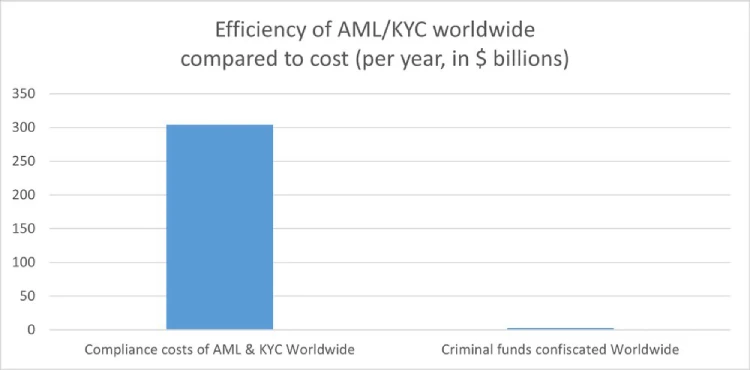
How will they keep this information safe? Why do they need my identity? Why do they force businesses to enforce such regulations? It's always for your safety, to protect you from the "bad". Your life is perpetually in danger: terrorists, money launderers, villains... so the government steps in to save us.
‟Hush now, baby, baby, don't you cry Mamma's gonna make all of your nightmares come true Mamma's gonna put all of her fears into you Mamma's gonna keep you right here, under her wing She won't let you fly, but she might let you sing Mamma's gonna keep baby cosy and warm” — Mother, Pink Floyd
We must resist any attack on our privacy and freedom. To do this, we must collaborate.
If you have a service, refuse to ask for KYC; find a way. Accept cryptocurrencies like Bitcoin and Monero. Commit to circular economies. Remove the need to go through the FIAT system. People need fiat money to use most services, but we can change that.
If you're a user, donate to and prefer using services that accept such currencies. Encourage your friends to accept cryptocurrencies as well. Boycott FIAT system to the greatest extent you possibly can.
This may sound utopian, but it can be achieved. This movement can't be stopped. Go kick the hornet's nest.
“We must defend our own privacy if we expect to have any. We must come together and create systems which allow anonymous transactions to take place. People have been defending their own privacy for centuries with whispers, darkness, envelopes, closed doors, secret handshakes, and couriers. The technologies of the past did not allow for strong privacy, but electronic technologies do.” — Eric Hughes, A Cypherpunk's Manifesto
The anniversary
Four years ago, I began exploring ways to use crypto without KYC. I bookmarked a few favorite services and thought sharing them to the world might be useful. That was the first version of kycnot.me — a simple list of about 15 services. Since then, I've added services, rewritten it three times, and improved it to what it is now.
kycnot.me has remained 100% independent and 100% open source^2 all these years. I've received offers to buy the site, all of which I have declined and will continue to decline. It has been DDoS attacked many times, but we made it through. I have also rewritten the whole site almost once per year (three times in four years).
The code and scoring algorithm are open source (contributions are welcome) and I can't arbitrarly change a service's score without adding or removing attributes, making any arbitrary alterations obvious if they were fake. You can even see the score summary for any service's score.
I'm a one-person team, dedicating my free time to this project. I hope to keep doing so for many more years. Again, thank you for being part of this.
-
 @ 39cc53c9:27168656
2025-05-27 09:21:38
@ 39cc53c9:27168656
2025-05-27 09:21:38
Silent.link is an anonymous eSIM provider. They offer pay-as-you-go roaming in 160+ countries.
Pros
- Anonymous
- Private payment options
- High performance
- Global availability
Cons
- Need to select the right networks sometimes
- Latency
- Data and incoming SMS & call only
Rating
★★★★★
Service website
eSIMs replace traditional, physical SIM cards, if you have a fairly new phone, odds are it supports them. Since most people change their mobile carrier very rarely, the most common use case for these new eSIMs is their use in travel. Although their use as a piece of a larger OPSEC puzzle to improve privacy when using the internet from your phone is increasingly popular too.
Silent.link is not the only eSIM provider out there. Yet, they’re so unique that even Twitter’s (now X) founder Jack Dorsey recommends them.
Let’s start off with a quick explanation of how Silent.link works and what pay-as-you-go means. Most other eSIM providers will sell you packages of GBs with an expiration date. For instance imagine you’re visiting France then going to the UK after a few months. With other providers you might buy a 10GB in France package valid for 7 days, then after some months a 10GB in the UK package also valid for 7 days. You likely won’t use up the full package in either country and the remaining capacity will be voided as the package expires.
Silent.link’s pay-as-you-go is different. There are no geographic packages. There are no expiration dates. You simply have a balance denominated in USD and are charged as you use up the data according to the pricing of whichever local carrier you’re connecting via.
Preparing for the same trips from the example above you’d simply top-up your Silent.link balance with $10. Then you’d use Silent.link in France paying $1.33/GB, you’d only be charged for the exact amount used, then you’d go to the UK and pay $1.54/GB from the balance you had left over from France. It doesn’t matter how much time passes between the trips, because Silent.link balances don’t expire. If you have a balance left over you can use it on a future trip, or simply use it up in your home country.
Pros
Anonymity
Silent.link is anonymous. Most other eSIM providers require some form of identification. This can be a traditional, full KYC, procedure involving your ID or passport numbers or, as seemingly innocent, as verifying your phone number with your main carrier. Regardless, a link between the eSIM you bought online and your identity is established.
In some countries you’ll be able to pick up a traditional SIM (or the new eSIM) from a local carrier without undergoing this verification. This can still be a hassle though. You’ll need to look up the laws before travelling, you’ll need to find a local store selling them, you’ll need to decide how you’ll pay privately, etc. And that’s the best case, that’s assuming the country you want to get the SIM in allows you to buy one anonymously.
Private payment methods
Silent.link only accepts cryptocurrency and according to their stats, most payments are made with Bitcoin (either onchain or using the Lightning Network) or with Monero. As such paying anonymously is not a problem. The use a self-hosted instance of BTCPay Server to process payments and operate their own LN node. The entire checkout process can be completed over Tor.
Cons
Network selection
Although you can skip the hassle of buying a new eSIM every time you travel it’s a good idea to look up the pricing of different mobile networks in the country you’re going to. The differences can be trivial, but can also be 100x. If a specific mobile network offers a much better deal, you’ll probably want to dive into your phone’s settings to make sure it only connects to that network.
High prices for some regions
Second issue can be that, especially for poorer countries, Silent.link might not have the best prices. For instance if you travel to Angola you’ll end up paying $155.44/GB. But if you search around for other providers you’ll find eSIM that offer much lower prices for that same country.
Data & incoming SMS & calls only
These eSIMs are either data-only or only offer data and inbound sms and calls. You can’t use Silent.link eSIMs to send texts or make phone calls.
Latency
For most use-cases this shouldn’t matter, but the way roaming works is that when you’re abroad your data is first sent to your home country then sent out into the internet from there. For instance if you’re a Brit on holiday in Spain wherever you open up a website your phone communicates with the Spanish network who forwards the request to your home network in the UK and only there does the request start going towards the website you’re trying to load. The response takes the same path in reverse.
The home network for the Silent.link eSIMs is Poland. To take an extreme (antipodal) example, if you’re in Chile loading a Chilean website your request will go to Poland then back from Poland to the website’s server in Chile, then the response will go from Chile to Poland to you (in Chile). All those trips add latency. In our testing, done during the recent OrangeFren.com meetup in Istanbul, the difference was an additional 73ms. The bandwidth, however, was exceptional, easily surpassing 100 Mbps.
This latency issue isn’t unique to Silent.link, other eSIM providers usually suffer from it too, though their home network may be better suited for your latency needs. If you need the best latency we recommend a SIM from a local provider (or WiFi).
This proxy behaviour isn’t all negative however. It may potentially allow you to circumvent censorship or geoblocking if you’re trying to access resources available from Poland, but unavailable elsewhere.
Besides Istanbul one of the countries we also tested Silent.link in was Northern Cyprus. This territory is mostly unrecognized. It’s a country that, depending on who you ask, is or isn’t real. Despite this unresolved geopolitical status Silent.link performed without any issues.
Installation
If you decide to give Silent.link a try, you'll need to select if you want a data-only plan or a plan with inbound SMS & calling, once you complete the payment simply scan the QR code on the order confirmation page with your phone. Make sure to save the url of that order confirmation page somewhere! You will need it to top up your eSIM and check your remaining balance.
Getting in touch
The preferred way of contacting Silent.link's support is using the website's built-in chat function. Alternative methods include X (formerly Twitter), Matrix and email.
Their support is online from 09:00 - 21:00 UTC although even when testing outside of those hours we got a reply within a minute.
NOTE: These reviews are sponsored, yet the sponsorship does not influence the outcome of the evaluations. Sponsored reviews are independent from the kycnot.me list, being only part of the blog. The reviews have no impact on the scores of the listings or their continued presence on the list. Should any issues arise, I will not hesitate to remove any listing.
-
 @ 39cc53c9:27168656
2025-05-27 09:21:37
@ 39cc53c9:27168656
2025-05-27 09:21:37After almost 3 months of work, we've completed the redesign of kycnot.me. More modern and with many new features.
Privacy remains the foundation - everything still works with JavaScript disabled. If you enable JS, you will get some nice-to-have features like lazy loading and smoother page transitions, but nothing essential requires it.
User Accounts
We've introduced user accounts that require zero personal information:
- Secret user tokens - no email, no phone number, no personal data
- Randomly generated usernames for default privacy and fairness
- Karma system that rewards contributions and unlocks features: custom display names, profile pictures, and more.
Reviews and Community Discussions
On the previous sites, I was using third party open source tools for the comments and discussions. This time, I've built my own from scratch, fully integrated into the site, without JavaScript requirements.
Everyone can share their experiences and help others make informed decisions:
- Ratings: Comments can have a 1-5 star rating attached. You can have one rating per service and it will affect the overall user score.
- Discussions: These are normal comments, you can add them on any listed service.
Comment Moderation
I was strugling to keep up with moderation on the old site. For this, we've implemented an AI-powered moderation system that:
- Auto-approves legitimate comments instantly
- Flags suspicious content for human review
- Keeps discussions valuable by minimizing spam
The AI still can mark comments for human review, but most comments will get approved automatically by this system. The AI also makes summaries of the comments to help you understand the overall sentiment of the community.
Powerful Search & Filtering
Finding exactly what you need is now easier:
- Advanced filtering system with many parameters. You can even filter by attributes to pinpoint services with specific features.
The results are dynamic and shuffle services with identical scores for fairness.
See all listings
Listings are now added as 'Community Contributed' by default. This means that you can still find them in the search results, but they will be clearly marked as such.
Updated Scoring System
New dual-score approach provides more nuanced service evaluations:
- Privacy Score: Measures how well a service protects your personal information and data
-
Trust Score: Assesses reliability, security, and overall reputation
-
Combined into a weighted Overall Score for quick comparisons
- Completely transparent and open source calculation algorithm. No manual tweaking or hidden factors.
AI-Powered Terms of Service Analysis
Basically, a TLDR summary for Terms of Service:
- Automated system extracts the most important points from complex ToS documents
- Clear summaries
- Updated monthly to catch any changes
The ToS document is hashed and only will be updated if there are any changes.
Service Events and Timelines
Track the complete history of any service, on each service page you can see the timeline of events. There are two types of events:
- Automatic events: Created by the system whenever something about a service changes, like its description, supported currencies, attributes, verification status…
- Manual events: Added by admins when there’s important news, such as a service going offline, being hacked, acquired, shut down, or other major updates.
There is also a global timeline view available at /events
Notification System
Since we now have user accounts, we built a notifiaction system so you can stay informed about anything:
- Notifications for comment replies and status changes
- Watch any comment to get notified for new replies.
- Subscribe to services to monitor events and updates
- Notification customization.
Coming soon: Third-party privacy-preserving notifications integration with Telegram, Ntfy.sh, webhooks...
Service Suggestions
Anyone with an account can suggest a new service via the suggestion form. After submitting, you'll receive a tracking page where you can follow the status of your suggestion and communicate directly with admins.
All new suggestions start as "unlisted" — they won't appear in search results until reviewed. Our team checks each submission to ensure it's not spam or inappropriate. If similar services already exist, you'll be shown possible duplicates and can choose to submit your suggestion as an edit instead.
You can always check the progress of your suggestion, respond to moderator questions, and see when it goes live, everything will also be notified to your account. This process ensures high-quality listings and a collaborative approach to building the directory.
These are some of the main features we already have, but there are many more small changes and improvements that you will find when using the site.
What's Next?
This is just the beginning. We will be constantly working to improve KYCnot.me and add more features that help you preserve your privacy.
Remember: True financial freedom requires the right to privacy. Stay KYC-free!
-
 @ b7274d28:c99628cb
2025-05-28 01:11:43
@ b7274d28:c99628cb
2025-05-28 01:11:43In this second installment of The Android Elite Setup tutorial series, we will cover installing the nostr:npub10r8xl2njyepcw2zwv3a6dyufj4e4ajx86hz6v4ehu4gnpupxxp7stjt2p8 on your #Android device and browsing for apps you may be interested in trying out.
Since the #Zapstore is a direct competitor to the Google Play Store, you're not going to be able to find and install it from there like you may be used to with other apps. Instead, you will need to install it directly from the developer's GitHub page. This is not a complicated process, but it is outside the normal flow of searching on the Play Store, tapping install, and you're done.
Installation
From any web browser on your Android phone, navigate to the Zapstore GitHub Releases page and the most recent version will be listed at the top of the page. The .apk file for you to download and install will be listed in the "Assets."
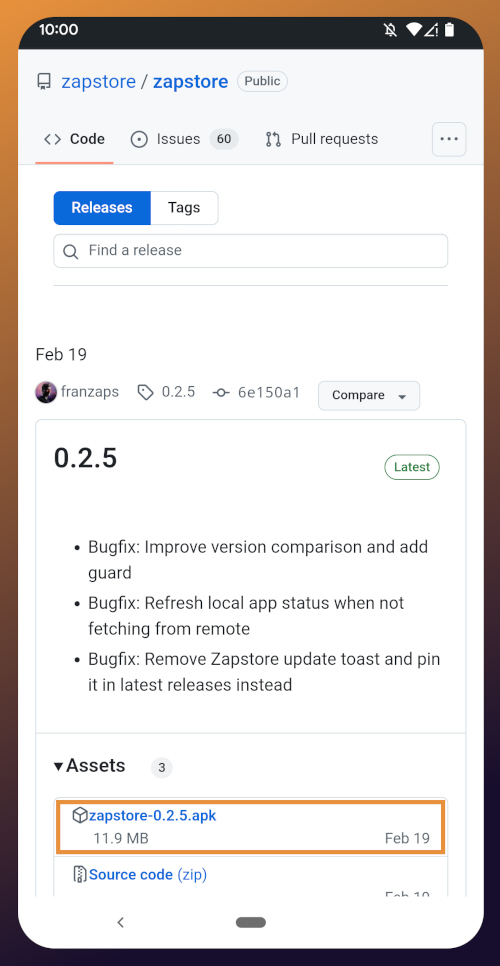
Tap the .apk to download it, and you should get a notification when the download has completed, with a prompt to open the file.
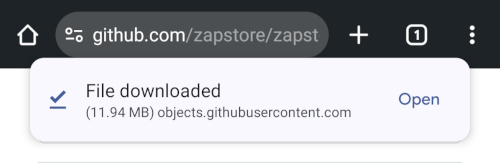
You will likely be presented with a prompt warning you that your phone currently isn't allowed to install applications from "unknown sources." Anywhere other than the Play Store is considered an "unknown source" by default. However, you can manually allow installation from unknown sources in the settings, which the prompt gives you the option to do.
In the settings page that opens, toggle it to allow installation from this source, and you should be prompted to install the application. If you aren't, simply go to your web browser's downloads and tap on the .apk file again, or go into your file browser app and you should find the .apk in your Downloads folder.
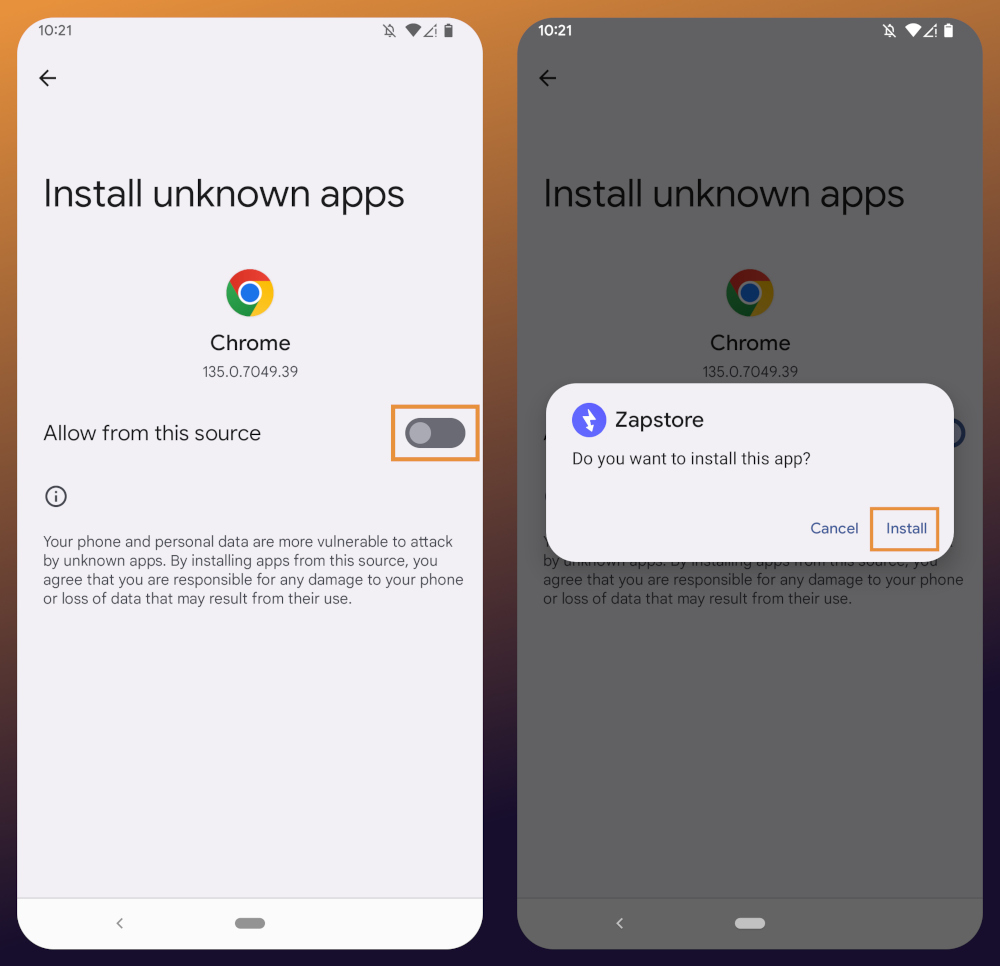
If the application doesn't open automatically after install, you will find it in your app drawer.
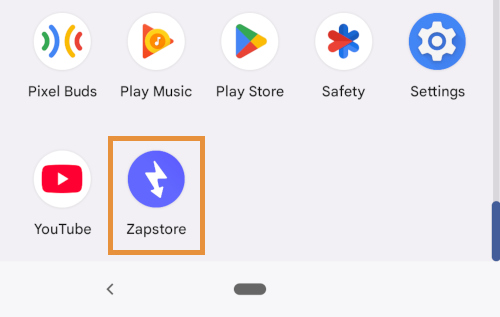
Home Page
Right at the top of the home page in the Zapstore is the search bar. You can use it to find a specific app you know is available in the Zapstore.

There are quite a lot of open source apps available, and more being added all the time. Most are added by the Zapstore developer, nostr:npub1wf4pufsucer5va8g9p0rj5dnhvfeh6d8w0g6eayaep5dhps6rsgs43dgh9, but some are added by the app developers themselves, especially Nostr apps. All of the applications we will be installing through the Zapstore have been added by their developers and are cryptographically signed, so you know that what you download is what the developer actually released.
The next section is for app discovery. There are curated app collections to peruse for ideas about what you may want to install. As you can see, all of the other apps we will be installing are listed in nostr:npub1wf4pufsucer5va8g9p0rj5dnhvfeh6d8w0g6eayaep5dhps6rsgs43dgh9's "Nostr" collection.
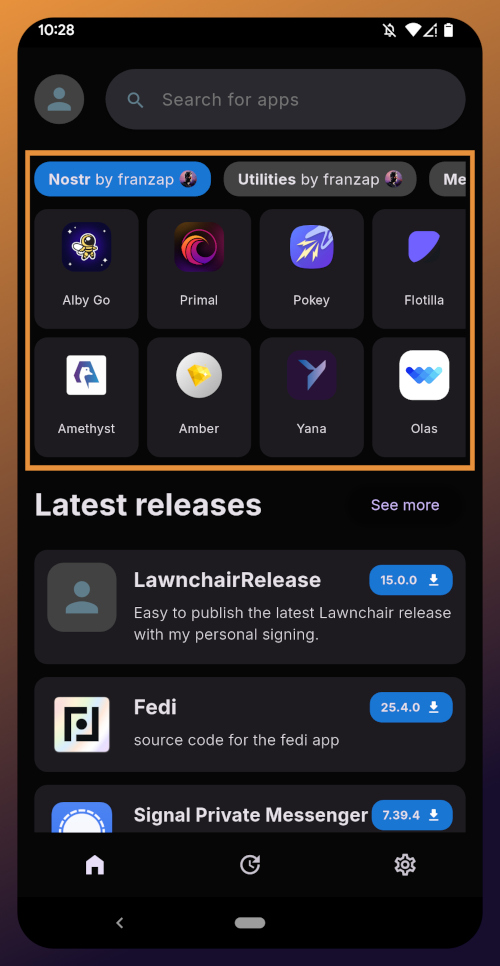
In future releases of the Zapstore, users will be able to create their own app collections.
The last section of the home page is a chronological list of the latest releases. This includes both new apps added to the Zapstore and recently updated apps. The list of recent releases on its own can be a great resource for discovering apps you may not have heard of before.
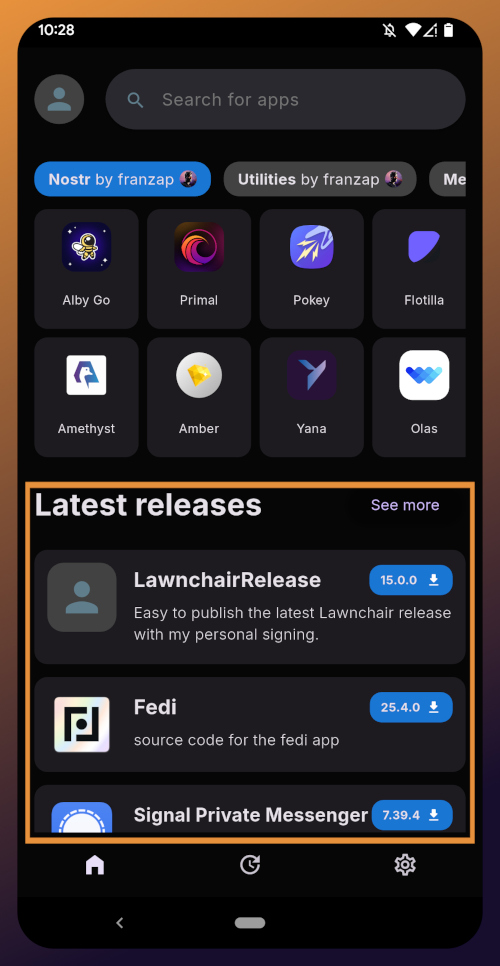
Installed Apps
The next page of the app, accessed by the icon in the bottom-center of the screen that looks like a clock with an arrow circling it, shows all apps you have installed that are available in the Zapstore. It's also where you will find apps you have previously installed that are ready to be updated. This page is pretty sparse on my test profile, since I only have the Zapstore itself installed, so here is a look at it on my main profile:
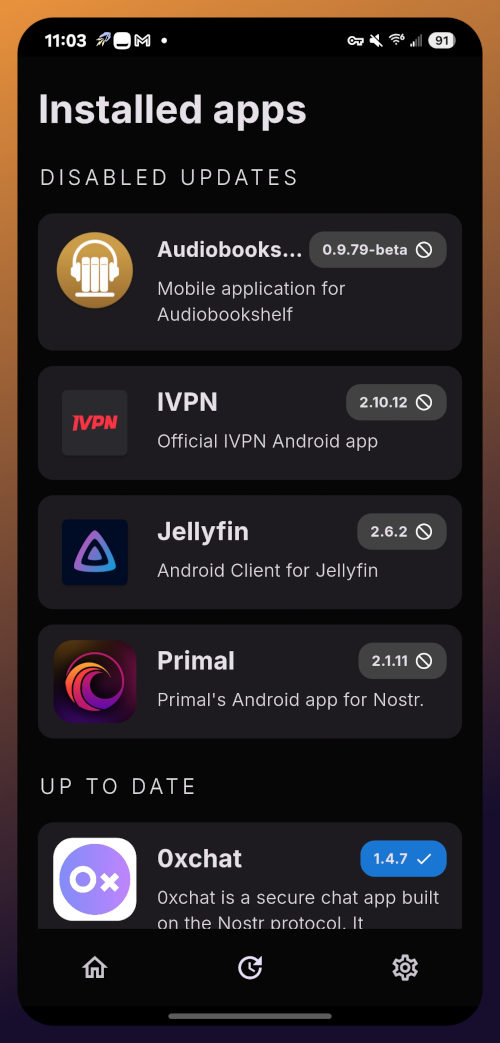
The "Disabled Apps" at the top are usually applications that were installed via the Play Store or some other means, but are also available in the Zapstore. You may be surprised to see that some of the apps you already have installed on your device are also available on the Zapstore. However, to manage their updates though the Zapstore, you would need to uninstall the app and reinstall it from the Zapstore instead. I only recommend doing this for applications that are added to the Zapstore by their developers, or you may encounter a significant delay between a new update being released for the app and when that update is available on the Zapstore.
Tap on one of your apps in the list to see whether the app is added by the developer, or by the Zapstore. This takes you to the application's page, and you may see a warning at the top if the app was not installed through the Zapstore.
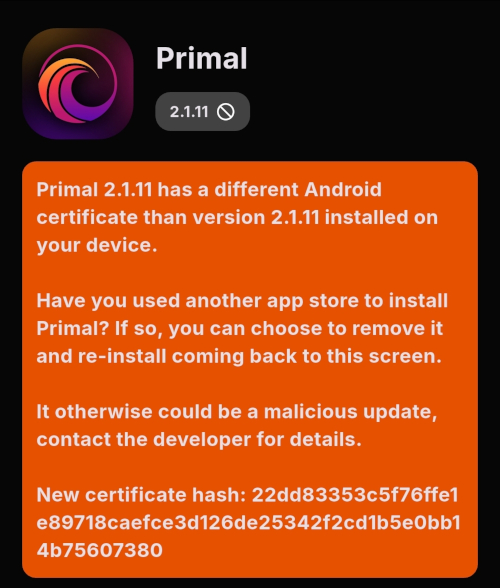
Scroll down the page a bit and you will see who signed the release that is available on the Zapstore.

In the case of Primal, even though the developer is on Nostr, they are not signing their own releases to the Zapstore yet. This means there will likely be a delay between Primal releasing an update and that update being available on the Zapstore.
Settings
The last page of the app is the settings page, found by tapping the cog at the bottom right.
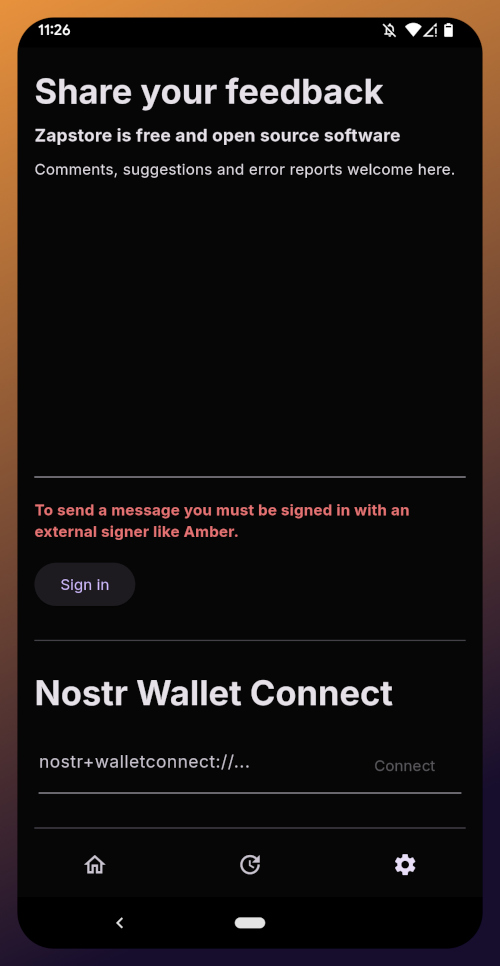
Here you can send the Zapstore developer feedback directly (if you are logged in), connect a Lightning wallet using Nostr Wallet Connect, delete your local cache, and view some system information.
We will be adding a connection to our nostr:npub1h2qfjpnxau9k7ja9qkf50043xfpfy8j5v60xsqryef64y44puwnq28w8ch wallet in part 5 of this tutorial series.
For the time being, we are all set with the Zapstore and ready for the next stage of our journey.
Continue to Part 3: Amber Signer. Nostr link: nostr:naddr1qqxnzde5xuengdeexcmnvv3eqgstwf6d9r37nqalwgxmfd9p9gclt3l0yc3jp5zuyhkfqjy6extz3jcrqsqqqa28qy2hwumn8ghj7un9d3shjtnyv9kh2uewd9hj7qg6waehxw309aex2mrp0yhxyunfva58gcn0d36zumn9wss80nug
-
 @ b7274d28:c99628cb
2025-05-28 00:59:49
@ b7274d28:c99628cb
2025-05-28 00:59:49Your identity is important to you, right? While impersonation can be seen in some senses as a form of flattery, we all would prefer to be the only person capable of representing ourselves online, unless we intentionally delegate that privilege to someone else and maintain the ability to revoke it.
Amber does all of that for you in the context of #Nostr. It minimizes the possibility of your private key being compromized by acting as the only app with access to it, while all other Nostr apps send requests to Amber when they need something signed. This even allows you to give someone temporary authority to post as you without giving them your private key, and you retain the authority to revoke their permissions at any time.
nostr:npub1w4uswmv6lu9yel005l3qgheysmr7tk9uvwluddznju3nuxalevvs2d0jr5 has provided Android users with an incredibly powerful tool in Amber, and he continues to improve its functionality and ease of use. Indeed, there is not currently a comparative app available for iOS users. For the time being, this superpower is exclusive to Android.
Installation
Open up the Zapstore app that you installed in the previous stage of this tutorial series.
Very likely, Amber will be listed in the app collection section of the home page. If it is not, just search for "Amber" in the search bar.

Opening the app's page in the Zapstore shows that the release is signed by the developer. You can also see who has added this app to one of their collections and who has supported this app with sats by zapping the release.
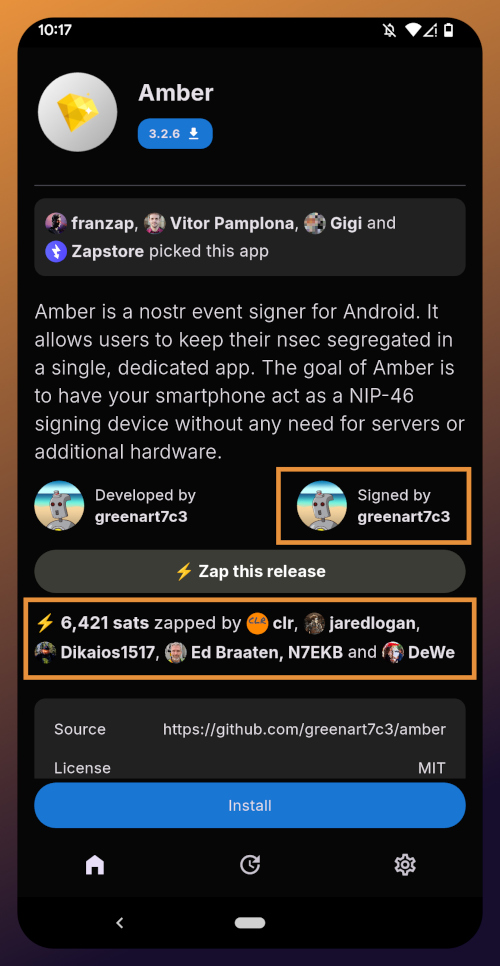
Tap "Install" and you will be prompted to confirm you are sure you want to install Amber.
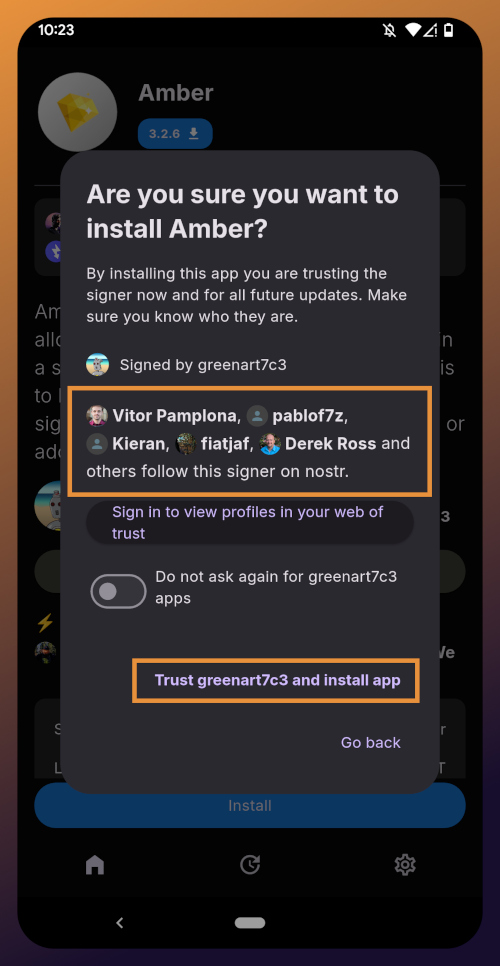
Helpfully, you are informed that several other users follow this developer on Nostr. If you have been on Nostr a while, you will likely recognize these gentlemen as other Nostr developers, one of them being the original creator of the protocol.
You can choose to never have Zapstore ask for confirmation again with apps developed by nostr:npub1w4uswmv6lu9yel005l3qgheysmr7tk9uvwluddznju3nuxalevvs2d0jr5, and since we have another of his apps to install later in this tutorial series, I recommend you toggle this on. Then tap on "Trust greenart7c3 and install app."
Just like when you installed the Zapstore from their GitHub, you will be prompted to allow the Zapstore to install apps, since Android considers it an "unknown source."
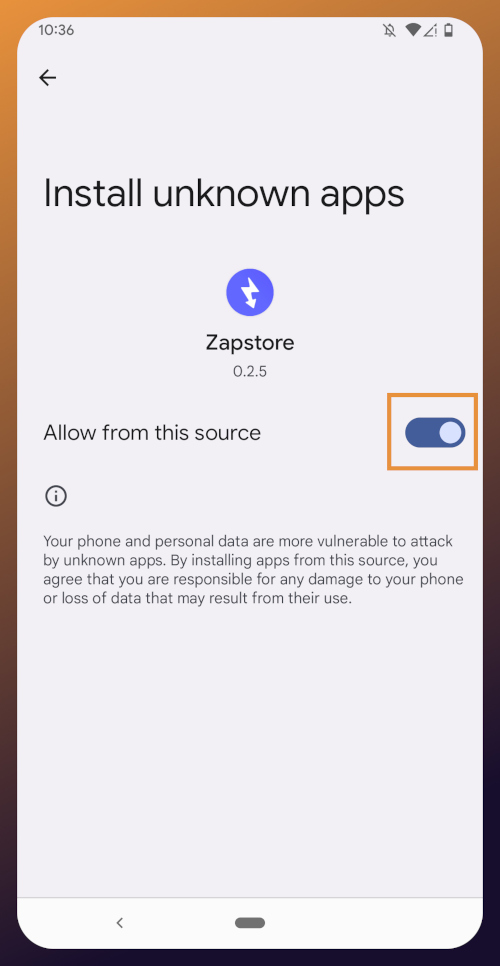
Once you toggle this on and use the back button to get back to the Zapstore, Amber will begin downloading and then present a prompt to install the app. Once installed, you will see a prompt that installation was a success and you can now open the app.

From here, how you proceed will depend on whether you need to set up a new Nostr identity or use Amber with an existing private key you already have set up. The next section will cover setting up a new Nostr identity with Amber. Skip to the section titled "Existing Nostrich" if you already have an nsec that you would like to use with Amber.
New Nostrich
Upon opening the application, you will be presented with the option to use an existing private key or create a new Nostr account. Nostr doesn't really have "accounts" in the traditional sense of the term. Accounts are a relic of permissioned systems. What you have on Nostr are keys, but Amber uses the "account" term because it is a more familiar concept, though it is technically inaccurate.
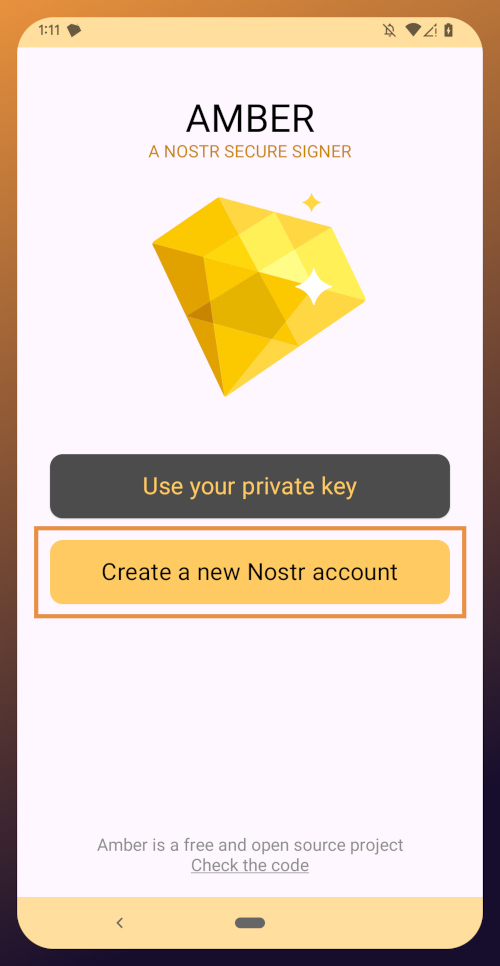
Choose "Create a new Nostr account" and you will be presented with a screen telling you that your Nostr account is ready. Yes, it was really that easy. No email, no real name, no date of birth, and no annoying capcha. Just "Create a new account" and you're done.
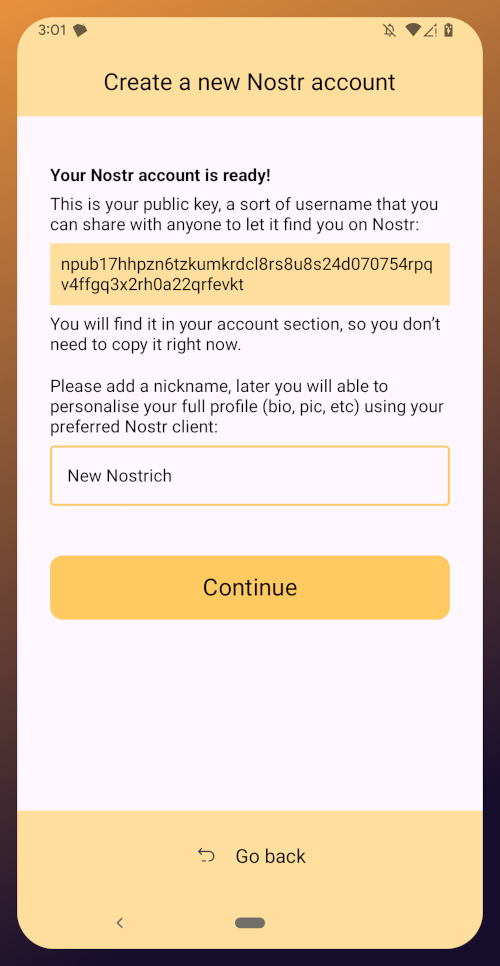
The app presents you with your public key. This is like an address that can be used to find your posts on Nostr. It is 100% unique to you, and no one else can post a note that lists this npub as the author, because they won't have the corresponding private key. You don't need to remember your npub, though. You'll be able to readily copy it from any Nostr app you use whenever you need it.
You will also be prompted to add a nickname. This is just for use within Amber, since you can set up multiple profiles within the app. You can use anything you want here, as it is just so you can tell which profile is which when switching between them in Amber.
Once you've set your nickname, tap on "Continue."
The next screen will ask you what Amber's default signing policy should be.
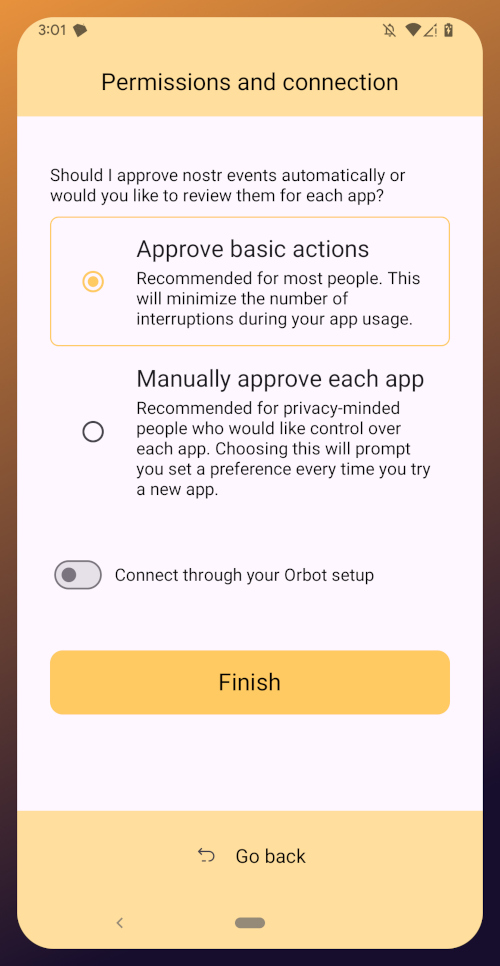
The default is to approve basic actions, referring to things that are common for Nostr clients to request a signature for, like following another user, liking a post, making a new post, or replying. If you are more concerned about what Amber might be signing for on your behalf, you can tell it to require manual approval for each app.
Once you've made your decision, tap "Finish." You will also be able to change this selection in the app settings at any time.
With this setup out of the way, you are now presented with the main "Applications" page of the app.
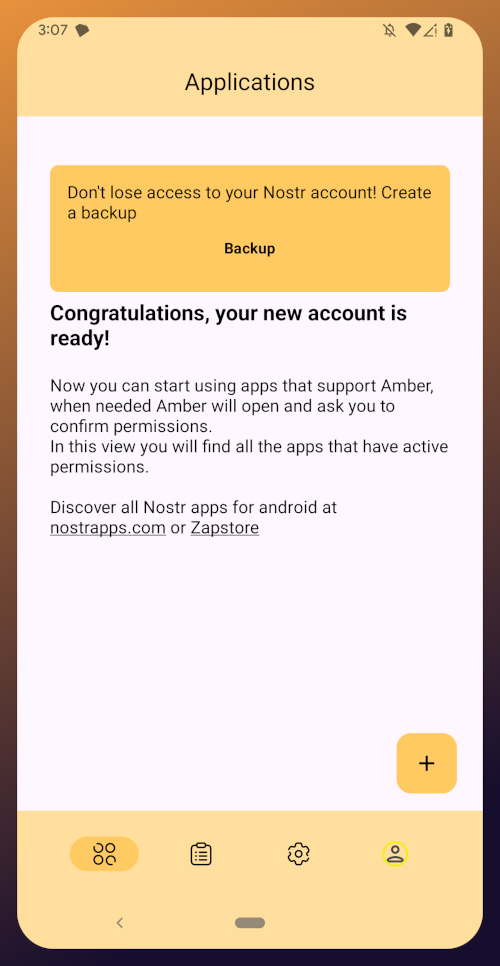
At the top, you have a notification encouraging you to create a backup. Let's get that taken care of now by tapping on the notification and skipping down to the heading titled "Backing Up Your Identity" in this tutorial.
Existing Nostrich
Upon opening the application, you will be presented with the option to use your private key or create a new Nostr account. Choose the former.
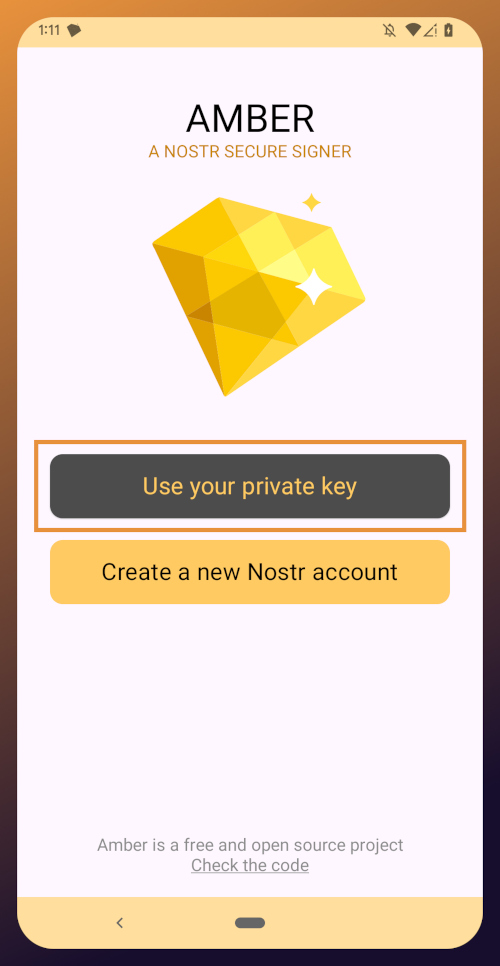
The next screen will require you to paste your private key.
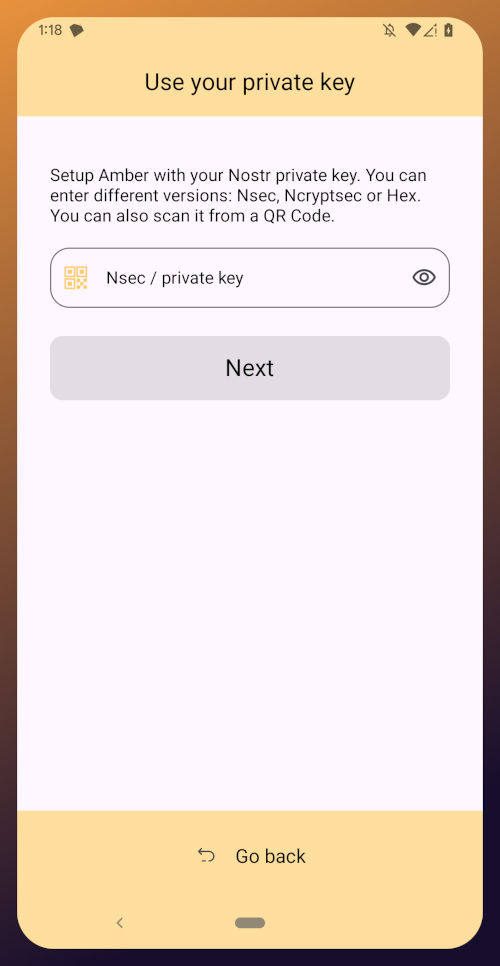
You will need to obtain this from whatever Nostr app you used to create your profile, or any other Nostr app that you pasted your nsec into in the past. Typically you can find it in the app settings and there will be a section mentioning your keys where you can copy your nsec. For instance, in Primal go to Settings > Keys > Copy private key, and on Amethyst open the side panel by tapping on your profile picture in the top-left, then Backup Keys > Copy my secret key.
After pasting your nsec into Amber, tap "Next."

Amber will give you a couple options for a default signing policy. The default is to approve basic actions, referring to things that are common for Nostr clients to request a signature for, like following another user, liking a post, making a new post, or replying. If you are more concerned about what Amber might be signing for on your behalf, you can tell it to require manual approval for each app.
Once you've made your decision, tap "Finish." You will also be able to change this selection in the app settings at any time.
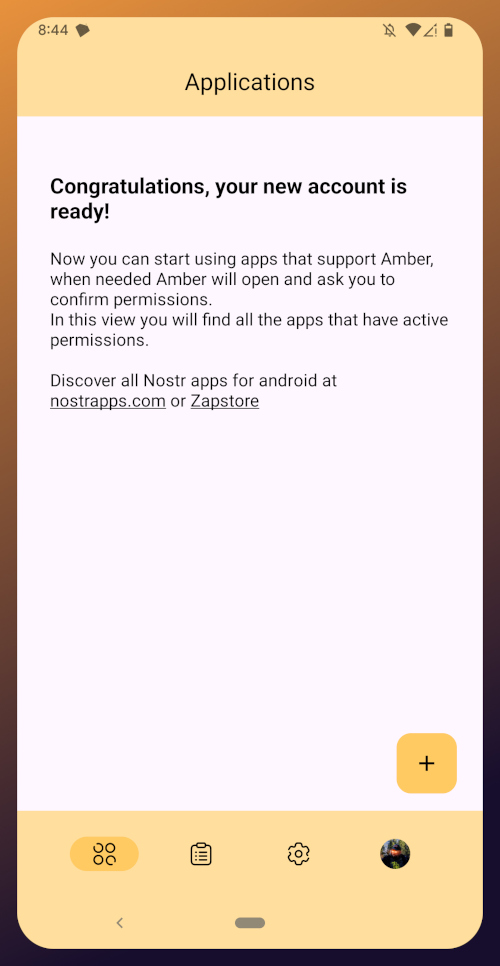
With this setup out of the way, you are now presented with the main "Applications" page of the app. You have nothing here yet, since you haven't used Amber to log into any Nostr apps, but this will be where all of the apps you have connected with Amber will be listed, in the order of the most recently used at the top.
Before we go and use Amber to log into an app, though, let's make sure we've created a backup of our private key. You pasted your nsec into Amber, so you could just save that somewhere safe, but Amber gives you a few other options as well. To find them, you'll need to tap the cog icon at the bottom of the screen to access the settings, then select "Backup Keys."

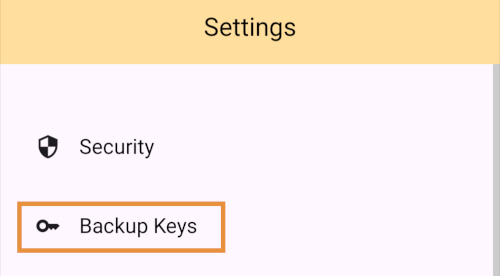
Backing Up Your Identity
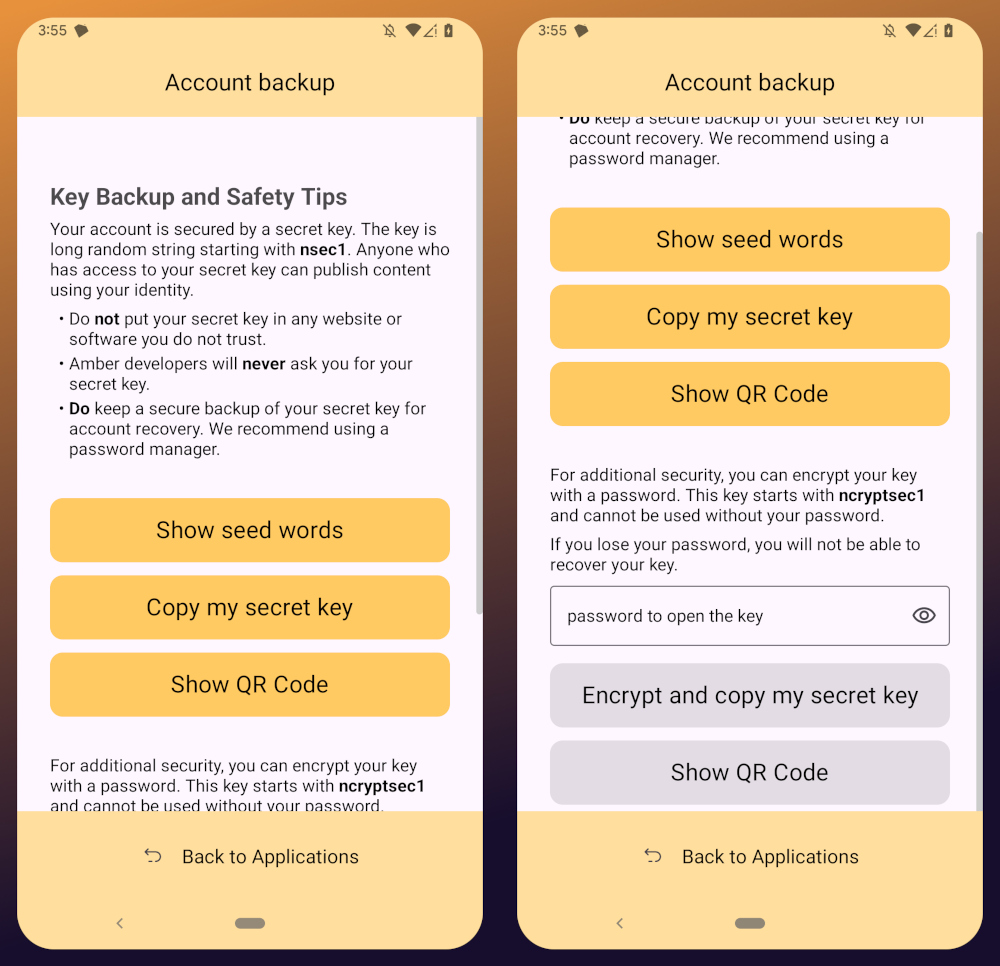
You'll notice that Amber has a few different options for backing up your private key that it can generate.
First, it can give you seed words, just like a Bitcoin seed. If you choose that option, you'll be presented with 12 words you can record somewhere safe. To recover your Nostr private key, you just have to type those words into a compatible application, such as Amber.
The next option is to just copy the secret/private key in its standard form as an "nsec." This is the least secure way to store it, but is also the most convenient, since it is simple to paste into another signer application. If you want to be able to log in on a desktop web app, the browser extension Nostr signers won't necessarily support entering your 12 word seed phrase, but they absolutely will support pasting in your nsec.
You can also display a QR code of your private key. This can be scanned by Amber signer on another device for easily transferring your private key to other devices you want to use it on. Say you have an Android tablet in addition to your phone, for instance. Just make sure you only use this function where you can be certain that no one will be able to get a photograph of that QR code. Once someone else has your nsec, there is no way to recover it. You have to start all over on Nostr. Not a big deal at this point in your journey if you just created a Nostr account, but if you have been using Nostr for a while and have built up a decent amount of reputation, it could be much more costly to start over again.
The next options are a bit more secure, because they require a password that will be used to encrypt your private key. This has some distinct advantages, and a couple disadvantages to be aware of. Using a password to encrypt your private key will give you what is called an ncryptsec, and if this is leaked somehow, whoever has it will not necessarily have access to post as you on Nostr, the way they would if your nsec had been leaked. At least, not so long as they don't also have your password. This means you can store your ncryptsec in multiple locations without much fear that it will be compromised, so long as the password you used to encrypt it was a strong and unique one, and it isn't stored in the same location. Some Nostr apps support an ncryptsec for login directly, meaning that you have the option to paste in your ncryptsec and then just log in with the password you used to encrypt it from there on out. However, now you will need to keep track of both your ncryptsec and your password, storing both of them safely and separately. Additionally, most Nostr clients and signer applications do not support using an ncryptsec, so you will need to convert it back to a standard nsec (or copy the nsec from Amber) to use those apps.
The QR option using an ncryptsec is actually quite useful, though, and I would go this route when trying to set up Amber on additional devices, since anyone possibly getting a picture of the QR code is still not going to be able to do anything with it, unless they also get the password you used to encrypt it.
All of the above options will require you to enter the PIN you set up for your device, or biometric authentication, just as an additional precaution before displaying your private key to you.
As for what "store it in a safe place" looks like, I highly recommend a self-hosted password manager, such as Vaultwarden+Bitwarden or KeePass. If you really want to get wild, you can store it on a hardware signing device, or on a steel seed plate.
Additional Settings
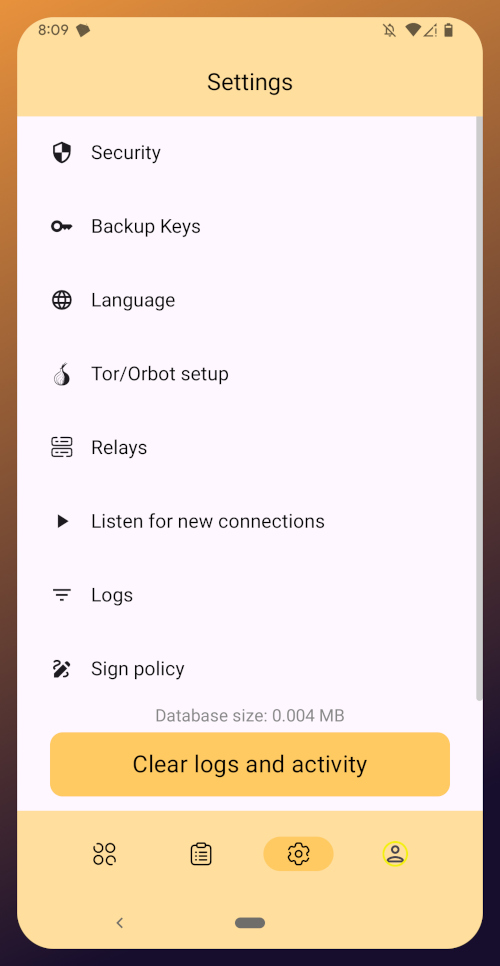
Amber has some additional settings you may want to take advantage of. First off, if you don't want just anyone who has access to your phone to be able to approve signing requests, you can go into the Security settings add a PIN or enable biometrics for signing requests. If you enable the PIN, it will be separate from the PIN you use to access your phone, so you can let someone else use your phone, like your child who is always begging to play a mobile game you have installed, without worrying that they might have access to your Nostr key to post on Amethyst.
Amber also has some relay settings. First are the "Active relays" which are used for signing requests sent to Amber remotely from Nostr web apps. This is what enables you to use Amber on your phone to log into Nostr applications on your desktop web browser, such as Jumble.social, Coracle.social, or Nostrudel.ninja, eliminating your need to use any other application to store your nsec whatsoever. You can leave this relay as the default, or you can add other relays you want to use for signing requests. Just be aware, not all relays will accept the notes that are used for Nostr signing requests, so make sure that the relay you want to use does so. In fact, Amber will make sure of this for you when you type in the relay address.
The next type of relays that you can configure in Amber are the "Default profile relays." These are used for reading your profile information. If you already had a Nostr identity that you imported to Amber, you probably noticed it loaded your profile picture and display name, setting the latter as your nickname in Amber. These relays are where Amber got that information from. The defaults are relay.nostr.band and purplepag.es. The reason for this is because they are aggregators that look for Nostr profiles that have been saved to other relays on the network and pull them in. Therefore, no matter what other relay you may save your profile to, Amber will likely be able to find it on one of those two relays as well. If you have a relay you know you will be saving your Nostr profiles to, you may want to add it to this list.
You can also set up Amber to be paired with Orbot for signing over Tor using relays that are only accessible via the Tor network. That is an advanced feature, though, and well beyond the scope of this tutorial.
Finally, you can update the default signing policy. Maybe after using Amber for a while, you've decided that the choice you made before was too strict or too lenient. You can change it to suit your needs.
Zapstore Login
Now that you are all set up with Amber, let's get you signed into your first Nostr app by going back to the Zapstore.
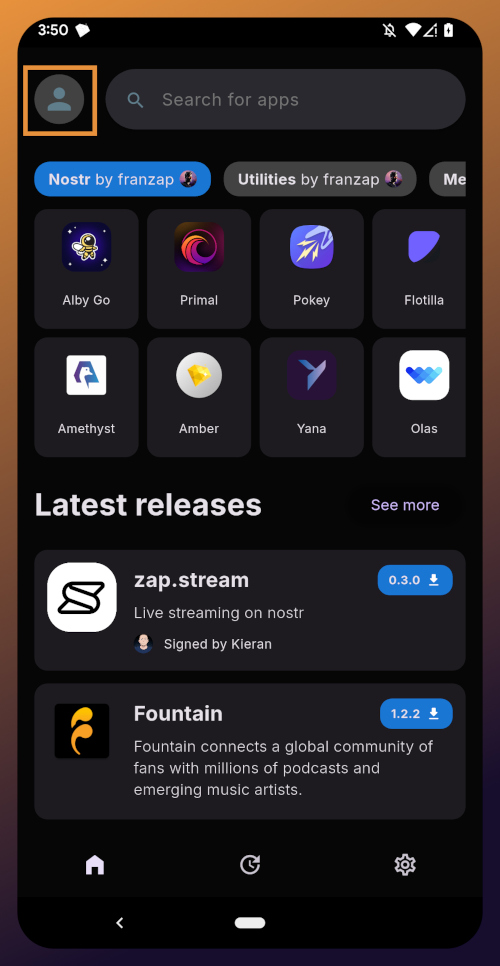
From the app's home screen, tap on the user icon in the upper left of the screen. This will open a side panel with not much on it except the option to "sign in." Go ahead and tap on it.
You will be presented with the option to either sign in with Amber, or to paste your npub. However, if you do the latter, you will only have read access, meaning you cannot zap any of the app releases. There are other features planned for the Zapstore that may also require you to be signed in with write access, so go ahead and choose to log in with Amber.
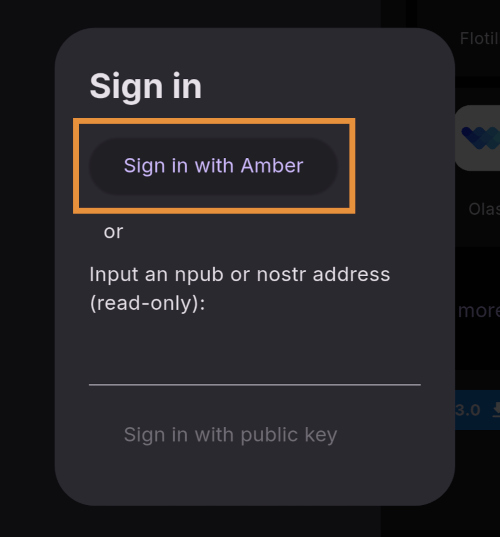
Your phone should automatically switch to Amber to approve the sign-in request.
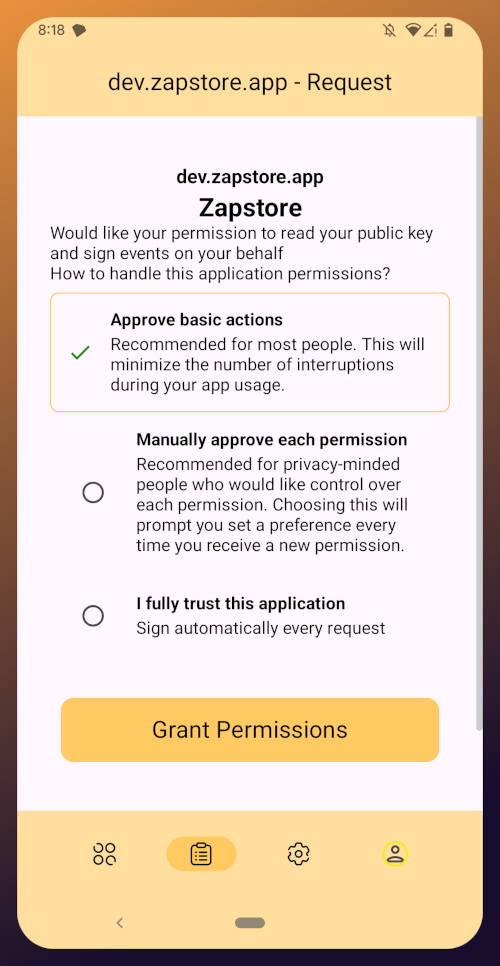
You can choose to only approve basic actions for Zapstore, require it to manually approve every time, or you can tell it that you "fully trust this application." Only choose the latter option with apps you have used for a while and they have never asked you to sign for anything suspicious. For the time being, I suggest you use the "Approve basic actions" option and tap "Grant Permissions."
Your phone will switch back to the Zapstore and will show that you are now signed in. Congratulations! From here on out, logging into most Nostr applications will be as easy as tapping on "Log in with Amber" and approving the request.

If you set up a new profile, it will just show a truncated version of your npub rather than the nickname you set up earlier. That's fine. You'll have an opportunity to update your Nostr profile in the next tutorial in this series and ensure that it is spread far and wide in the network, so the Zapstore will easily find it.
That concludes the tutorial for Amber. While we have not covered using Amber to log into Nostr web apps, that is outside the scope of this series, and I will cover it in an upcoming tutorial regarding using Amber's remote signer options in detail.
Since you're already hanging out in the Zapstore, you may as well stick around, because we will be using it right out the gate in the next part of this series: Amethyst Installation and Setup. (Coming Soon)
-
 @ c1e9ab3a:9cb56b43
2025-05-27 16:19:06
@ c1e9ab3a:9cb56b43
2025-05-27 16:19:06Star Wars is often viewed as a myth of rebellion, freedom, and resistance to tyranny. The iconography—scrappy rebels, totalitarian stormtroopers, lone smugglers—suggests a deep anti-authoritarian ethos. Yet, beneath the surface, the narrative arc of Star Wars consistently affirms the necessity, even sanctity, of central authority. This blog entry introduces the question: Is Star Wars fundamentally a celebration of statism?
Rebellion as Restoration, Not Revolution
The Rebel Alliance’s mission is not to dismantle centralized power, but to restore the Galactic Republic—a bureaucratic, centrally governed institution. Characters like Mon Mothma and Bail Organa are high-ranking senators, not populist revolutionaries. The goal is to remove the corrupt Empire and reinstall a previous central authority, presumed to be just.
- Rebels are loyalists to a prior state structure.
- Power is not questioned, only who wields it.
Jedi as Centralized Moral Elites
The Jedi, often idealized as protectors of peace, are unelected, extra-legal enforcers of moral and military order. Their authority stems from esoteric metaphysical abilities rather than democratic legitimacy.
- They answer only to their internal Council.
- They are deployed by the Senate, but act independently of civil law.
- Their collapse is depicted as tragic not because they were unaccountable, but because they were betrayed.
This positions them as a theocratic elite, not spiritual anarchists.
Chaos and the Frontier: The Case of the Cantina
The Mos Eisley cantina, often viewed as a symbol of frontier freedom, reveals something darker. It is: - Lawless - Violent - Culturally fragmented
Conflict resolution occurs through murder, not mediation. Obi-Wan slices off a limb; Han shoots first—both without legal consequence. There is no evidence of property rights, dispute resolution, or voluntary order.
This is not libertarian pluralism—it’s moral entropy. The message: without centralized governance, barbarism reigns.
The Mythic Arc: Restoration of the Just State
Every trilogy in the saga returns to a single theme: the fall and redemption of legitimate authority.
- Prequels: Republic collapses into tyranny.
- Originals: Rebels fight to restore legitimate order.
- Sequels: Weak governance leads to resurgence of authoritarianism; heroes must reestablish moral centralism.
The story is not anti-state—it’s anti-bad state. The solution is never decentralization; it’s the return of the right ruler or order.
Conclusion: The Hidden Statism of a Rebel Myth
Star Wars wears the costume of rebellion, but tells the story of centralized salvation. It: - Validates elite moral authority (Jedi) - Romanticizes restoration of fallen governments (Republic) - Portrays decentralized zones as corrupt and savage (outer rim worlds)
It is not an anarchist parable, nor a libertarian fable. It is a statist mythology, clothed in the spectacle of rebellion. Its core message is not that power should be abolished, but that power belongs to the virtuous few.
Question to Consider:
If the Star Wars universe consistently affirms the need for centralized moral and political authority, should we continue to see it as a myth of freedom? Or is it time to recognize it as a narrative of benevolent empire? -
 @ c1e9ab3a:9cb56b43
2025-05-27 13:19:53
@ c1e9ab3a:9cb56b43
2025-05-27 13:19:53I. Introduction: Money as a Function of Efficiency and Preference
Money is not defined by law, but by power over productivity. In any open economy, the most economically efficient actors—those who control the most valuable goods, services, and knowledge—ultimately dictate the medium of exchange. Their preferences signal to the broader market what form of money is required to access the highest-value goods, from durable commodities to intangibles like intellectual property and skilled labor.
Whatever money these actors prefer becomes the de facto unit of account and store of value, regardless of its legal status. This emergent behavior is natural and reflects a hierarchy of monetary utility.
II. Classical Gresham’s Law: A Product of Market Distortion
Gresham’s Law, famously stated as:
"Bad money drives out good"
is only valid under coercive monetary conditions, specifically: - Legal tender laws that force the acceptance of inferior money at par with superior money. - Fixed exchange rates imposed by decree, not market valuation. - Governments or central banks backing elastic fiduciary media with promises of redemption. - Institutional structures that mandate debt and tax payments in the favored currency.
Under these conditions, superior money (hard money) is hoarded, while inferior money (soft, elastic, inflationary) circulates. This is not an expression of free market behavior—it is the result of suppressed price discovery and legal coercion.
Gresham’s Law, therefore, is not a natural law of money, but a law of distortion under forced parity and artificial elasticity.
III. The Collapse of Coercion: Inversion of Gresham’s Law
When coercive structures weaken or are bypassed—through technological exit, jurisdictional arbitrage, monetary breakdown, or political disintegration—Gresham’s Law inverts:
Good money drives out bad.
This occurs because: - Market actors regain the freedom to select money based on utility, scarcity, and credibility. - Legal parity collapses, exposing the true economic hierarchy of monetary forms. - Trustless systems (e.g., Bitcoin) or superior digital instruments (e.g., stablecoins) offer better settlement, security, and durability. - Elastic fiduciary media become undesirable as counterparty risk and inflation rise.
The inversion marks a return to monetary natural selection—not a breakdown of Gresham’s Law, but the collapse of its preconditions.
IV. Elasticity and Control
Elastic fiduciary media (like fiat currency) are not intrinsically evil. They are tools of state finance and debt management, enabling rapid expansion of credit and liquidity. However, when their issuance is unconstrained, and legal tender laws force their use, they become weapons of economic coercion.
Banks issue credit unconstrained by real savings, and governments enforce the use of inflated media through taxation and courts. This distorts capital allocation, devalues productive labor, and ultimately hollows out monetary confidence.
V. Monetary Reversion: The Return of Hard Money
When the coercion ends—whether gradually or suddenly—the monetary system reverts. The preferences of the productive and wealthy reassert themselves:
- Superior money is not just saved—it begins to circulate.
- Weaker currencies are rejected not just for savings, but for daily exchange.
- The hoarded form becomes the traded form, and Gresham’s Law inverts completely.
Bitcoin, gold, and even highly credible stable instruments begin to function as true money, not just stores of value. The natural monetary order returns, and the State becomes a late participant, not the originator of monetary reality.
VI. Conclusion
Gresham’s Law operates only under distortion. Its inversion is not an anomaly—it is a signal of the collapse of coercion. The monetary system then reorganizes around productive preference, technological efficiency, and economic sovereignty.
The most efficient market will always dictate the form of hard money. The State can delay this reckoning through legal force, but it cannot prevent it indefinitely. Once free choice returns, bad money dies, and good money lives again.
-
 @ a396e36e:ec991f1c
2025-05-28 16:37:36
@ a396e36e:ec991f1c
2025-05-28 16:37:36👤 Generation X: Between Invisibility and Structural Disillusionment\ Generation X, born between 1965 and 1980, has been largely sidelined in generational discourse. Unlike the baby boomers —symbols of stability and prosperity— or millennials and Gen Z —constant fixtures in the media and cultural spotlight— Gen X has been the least mentioned, the least studied, and often not even recognized by its own members as a distinct generation.
Today, they are in midlife —a period that, according to the "U-shaped curve of happiness" theory, is one of the most emotionally and psychologically difficult stages: deteriorating health, professional stagnation, and the dual burden of caring for both parents and children. But their condition is not just a matter of age —it's the result of specific economic and political history.
Structurally, Generation X reached its critical stage of financial consolidation during the global economic crisis of 2008 —a moment that halted income growth and severely limited access to housing, investment opportunities, and saving capacity. Compared to other generations, their economic mobility was minimal, marked by wage stagnation and unstable labor conditions. Even in terms of wealth accumulation and home ownership, many Gen Xers show weaker indicators than early-born millennials at the same stage of adulthood.
At the same time, many countries —especially in Latin America and parts of Europe— experienced the rise of alternative models to free-market systems: socialist proposals promising redistribution, social justice, and equality. In practice, however, these models led to state dependency, excessive intervention, economic rigidity, and a loss of productive dynamism. The consequences were clear: rising poverty, institutional decay, inflation, plummeting investment, increasing corruption within state structures, and a severe weakening of the productive apparatus.
For a generation raised on the values of individual effort, self-reliance, and social mobility, this ideological shift resulted in a double disillusionment —first with a free-market system that never delivered the promised rewards, and then with a redistributive model that failed to solve structural problems and, in many cases, made them worse.
While younger generations now embrace proposals like universal basic income, nationalization, or permanent subsidies as fresh solutions, many in Gen X see them not as innovation, but as a repetition of mistakes already lived: economic stagnation, institutional fragility, sustained poverty, and expanding clientelist networks.
The story of Generation X is marked by having been the turning point between two collapsed models: a liberalism that never fulfilled its promises and a socialism that imposed dependency, corruption, and systematic impoverishment.
-
 @ 005bc4de:ef11e1a2
2025-05-28 16:24:41
@ 005bc4de:ef11e1a2
2025-05-28 16:24:41
Two days ago I put this out: https://peakd.com/hive-124838/@crrdlx/hostr-snaps-9i13ooa7ufp
 Post: https://peakd.com/hive-124838/@crrdlx/hostr-snaps-9i13ooa7ufp
Post: https://peakd.com/hive-124838/@crrdlx/hostr-snaps-9i13ooa7ufpOne of the comments said it "...looks like some sort of game as well." That was enough to tickle my curiosity and get me thinking. The round tomatoes and how they nestled into the grooves of the tiles reminded me of Chinese checkers. The grid brought Hex to mind (the game John Nash played) and I wondered if a square-grid version might be viable. A little searching revealed Hex is a "Connection game" and there are several. The one called Tak seemed really interesting and simple. I like interesting and I really like simple.
So, a square grid connection game wouldn't be new, however, you can't play Tak with tomatoes. Tak requires stacking "stones" or standing them on edge, that would be very, very tricky with tomatoes.
I looked around and happened to have some dried corn kernels and dry beans. I drew out a 5 x 5 grid of dots, lined up five corn kernels on one side in a "home row" and 5 beans on the other. We used to play a game where two sides of Army men met after a series of moves. In that game, we rolled dice to have a "combat" and see who would win the little battle. I wanted something like that in my game, some type of combat or conquest, somehow. So, I started messing around, moving kernels and beans, and totally just set out to make this game up on the fly. This is what I got...
Rules
The objective, like Hex or Tak, is to connect one side (your home row) to your opponent's side. The connection to the other side can be a straight line, or it CAN include a diagonal road. Any of the roads below would be a win for team bean (B).

- One side makes a move by sliding one corn/bean one spot forward.
- Then, take turns making moves.
- Movement can only be one spot forward/back or sideways (NSEW). You cannot move diagonally.
- Opponents CAN occupy, or "squat", on the same spot at once. If so, the spot is being "co-squatted" (they're like two people standing in the same sidewalk tile at the same time).
- However, while opponents occupy the same spot, a "combat" might ensue. A corn/bean can "attack" by moving yet another adjoining corn or bean onto the co-squatted spot. A conquest is made by outnumbering a spot 2-to-1. For instance, if a spot is being occupied by both a bean and corn, and then a second corn moves in, the two corns conquer the one bean. The bean is immediately removed. The bean player then places that conquered bean into any empty spot on his or her home row. That placement constitutes the bean player's turn. So, after the bean is placed on the home row, the corn player makes the next move.
- Play continues until someone completes a road from their home row across to their opponent's home row. (Again, a diagonal road is okay for the win.)
- The losing player got Succotashed.
Game name
As to the name, initially I wanted a tomato-ish name. But, I was using corn and beans. So, I'm naming this game "Succotash" after the corn, bean, and vegetable recipe. I considered calling it the "Texas Caviar Game" because it has tomatoes in it, but playing Succotash just sounds better. Plus, putting tomatoes in succotash sounds yummy.
Simple
A big goal here was to keep it simple. To that end, all that's needed is (a) a paper with a 5 x 5 grid drawn on it, and, (b) 5 pieces of something and 5 pieces of something else. Obviously I used corn kernels and beans, but it could easily be shells/legos, pennies/paperclips, nuts/stones, or whatever.
Initially, I had a "storehouse" of extra corn kernels and storehouse of extra beans (seen in the images). My thinking was that they would replace the corn or beans that get conquered by opponents. Upon playing the game, it was apparent that a storehouse is totally unnecessary. Once captured, the same corn/bean can just be the one that's placed back onto the home row. Five of each is fine.
Also, I'm sure the grid could easily be expanded to whatever size you wish. I played an opponent with the 5 x 5 grid, and that seemed a good size for a five minute or so game.
Why not sit down face-to-face with someone for a minute and give Succotash a try? If you do, I'd love to hear how it went.


-
 @ 9cb3545c:2ff47bca
2025-05-27 12:58:56
@ 9cb3545c:2ff47bca
2025-05-27 12:58:56Introduction
Public companies that hold Bitcoin on behalf of investors (often issuing securities backed by those Bitcoin holdings) have faced growing pressure to demonstrate proof of reserves – evidence that they genuinely hold the cryptocurrency they claim. One approach is to publish the company’s Bitcoin wallet addresses so that anyone can verify the balances on the blockchain. This practice gained momentum after high-profile crypto collapses (e.g. FTX in 2022) eroded trust, leading major exchanges and fund issuers like Binance, Kraken, OKX, and Bitwise to publicize wallet addresses as proof of assets . The goal is transparency and reassurance for investors. However, making wallet addresses public comes with significant security and privacy risks. This report examines those risks – from cybersecurity threats and blockchain tracing to regulatory and reputational implications – and weighs them against the transparency benefits of on-chain proof of reserves.
Proof of Reserves via Public Wallet Addresses
In the cryptocurrency ethos of “don’t trust – verify,” on-chain proof of reserves is seen as a powerful tool. By disclosing wallet addresses (or cryptographic attestations of balances), a company lets investors and analysts independently verify that the Bitcoin reserves exist on-chain. For example, some firms have dashboards showing their addresses and balances in real time . In theory, this transparency builds trust by proving assets are not being misreported or misused. Shareholders gain confidence that the company’s Bitcoin holdings are intact, potentially preventing fraud or mismanagement.
Yet this approach essentially sacrifices the pseudonymity of blockchain transactions. Publishing a wallet address ties a large, known institution to specific on-chain funds. While Bitcoin addresses are public by design, most companies treat their specific addresses as sensitive information. Public proof-of-reserve disclosures break that anonymity, raising several concerns as detailed below.
Cybersecurity Threats from Visible Wallet Balances
Revealing a wallet address with a large balance can make a company a prime target for hackers and cybercriminals. Knowing exactly where significant reserves are held gives attackers a clear blueprint. As Bitcoin advocate (and MicroStrategy Executive Chairman) Michael Saylor warned in 2025, “publicly known wallet addresses become prime targets for malicious actors. Knowing where significant reserves are held provides hackers with a clear target, potentially increasing the risk of sophisticated attacks” . In other words, publishing the address increases the attack surface – attackers might intensify phishing campaigns, malware deployment, or insider bribery aimed at obtaining the keys or access to those wallets.
Even if the wallets are secured in cold storage, a public address advertisement may encourage attempts to penetrate the organization’s security. Custodians and partners could also be targeted. Saylor noted that this exposure isn’t just risky for the company holding the Bitcoin; it can indirectly put their custodial providers and related exchanges at risk as well . For instance, if a third-party custodian manages the wallets, hackers might attempt to breach that custodian knowing the reward (the company’s Bitcoin) is great.
Companies themselves have acknowledged these dangers. Grayscale Investments, which runs the large Grayscale Bitcoin Trust (GBTC), pointedly refused to publish its wallet addresses in late 2022, citing “security concerns” and complex custody arrangements that have “kept our investors’ assets safe for years” . Grayscale implied that revealing on-chain addresses could undermine those security measures, and it chose not to “circumvent complex security arrangements” just to appease public demand . This highlights a key point: corporate treasury security protocols often assume wallet details remain confidential. Publicizing them could invalidate certain assumptions (for example, if an address was meant to be operationally secret, it can no longer serve that role once exposed).
Additionally, a publicly known trove of cryptocurrency might invite physical security threats. While not a purely “cyber” issue, if criminals know a particular company or facility controls a wallet with, say, thousands of Bitcoin, it could lead to threats against personnel (extortion or coercion to obtain keys). This is a less common scenario for large institutions (which typically have robust physical security), but smaller companies or key individuals could face elevated personal risk by being associated with huge visible crypto reserves.
In summary, cybersecurity experts consider public proof-of-reserve addresses a double-edged sword: transparency comes at the cost of advertising exactly where a fortune is held. As Saylor bluntly put it, “the conventional way of issuing proof of reserves today is actually insecure… This method undermines the security of the issuer, the custodian, the exchanges and the investors. This is not a good idea”  . From a pure security standpoint, broadcasting your wallets is akin to drawing a bullseye on them.
Privacy Risks: Address Clustering and Blockchain Tracing
Blockchain data is public, so publishing addresses opens the door to unwanted analytics and loss of privacy for the business. Even without knowing the private keys, analysts can scrutinize every transaction in and out of those addresses. This enables address clustering – linking together addresses that interact – and other forms of blockchain forensics that can reveal sensitive information about the company’s activities.
One immediate risk is that observers can track the company’s transaction patterns. For example, if the company moves Bitcoin from its reserve address to an exchange or to another address, that move is visible in real time. Competitors, investors, or even attackers could deduce strategic information: perhaps the company is planning to sell (if coins go to an exchange wallet) or is reallocating funds. A known institution’s on-chain movements can thus “reveal strategic movements or holdings”, eroding the company’s operational privacy . In a volatile market, advance knowledge of a large buy or sell by a major player could even be exploited by others (front-running the market, etc.).
Publishing one or a few static addresses also violates a basic privacy principle of Bitcoin: address reuse. Best practice in Bitcoin is to use a fresh address for each transaction to avoid linking them  . If a company continuously uses the same “proof of reserve” address, all counterparties sending funds to or receiving funds from that address become visible. Observers could map out the company’s business relationships or vendors by analyzing counterparties. A Reddit user commenting on an ETF that published a single address noted that “reusing a single address for this makes me question their risk management… There are much better and more privacy-preserving ways to prove reserves… without throwing everything in a single public address” . In other words, a naive implementation of proof-of-reserve (one big address) maximizes privacy leakage.
Even if multiple addresses are used, if they are all disclosed, one can perform clustering analysis to find connections. This happened in the Grayscale case: although Grayscale would not confirm any addresses, community analysts traced and identified 432 addresses likely belonging to GBTC’s custodial holdings by following on-chain traces from known intermediary accounts . They managed to attribute roughly 317,705 BTC (about half of GBTC’s holdings) to those addresses . This demonstrates that even partial information can enable clustering – and if the company directly published addresses, the task becomes even easier to map the entirety of its on-chain asset base.
Another threat vector is “dusting” attacks, which become more feasible when an address is publicly known. In a dusting attack, an adversary sends a tiny amount of cryptocurrency (dust) to a target address. The dust itself is harmless, but if the target address ever spends that dust together with other funds, it can cryptographically link the target address to other addresses in the same wallet. Blockchain security researchers note that “with UTXO-based assets, an attacker could distribute dust to an address to reveal the owner’s other addresses by tracking the dust’s movement… If the owner unknowingly combines this dust with their funds in a transaction, the attacker can… link multiple addresses to a single owner”, compromising privacy . A company that publishes a list of reserve addresses could be systematically dusted by malicious actors attempting to map out all addresses under the company’s control. This could unmask cold wallet addresses that the company never intended to publicize, further eroding its privacy and security.
Investor confidentiality is another subtle concern. If the business model involves individual investor accounts or contributions (for instance, a trust where investors can deposit or withdraw Bitcoin), public addresses might expose those movements. An outside observer might not know which investor corresponds to a transaction, but unusual inflows/outflows could signal actions by big clients. In extreme cases, if an investor’s own wallet is known (say a large investor announces their involvement), one might link that to transactions in the company’s reserve addresses. This could inadvertently reveal an investor’s activities or holdings, breaching expectations of confidentiality. Even absent direct identification, some investors might simply be uncomfortable with their transactions being part of a publicly traceable ledger tied to the company.
In summary, publishing reserve addresses facilitates blockchain tracing that can pierce the veil of business privacy. It hands analysts the keys to observe how funds move, potentially exposing operational strategies, counterparties, and internal processes. As one industry publication noted, linking a large known institution to specific addresses can compromise privacy and reveal more than intended . Companies must consider whether they are ready for that level of transparency into their every on-chain move.
Regulatory and Compliance Implications
From a regulatory perspective, wallet address disclosure lies in uncharted territory, but it raises several flags. First and foremost is the issue of incomplete information: A wallet address only shows assets, not the company’s liabilities or other obligations. Regulators worry that touting on-chain holdings could give a false sense of security. The U.S. Securities and Exchange Commission (SEC) has cautioned investors to “not place too much confidence in the mere fact a company says it’s got a proof-of-reserves”, noting that such reports “lack sufficient information” for stakeholders to ascertain if liabilities can be met . In other words, a public company might show a big Bitcoin address balance, but if it has debts or customer liabilities of equal or greater value, the proof-of-reserve alone is “not necessarily an indicator that the company is in a good financial position” .
This regulatory stance implies that address disclosure, if done, must be paired with proper context. A public company would likely need to clarify in its financial statements or investor communications that on-chain reserves are unencumbered (not pledged as loan collateral, not already sold forward, etc.) and that total liabilities are accounted for. Otherwise, there’s a risk of misleading investors, which could have legal consequences. For example, if investors interpret the on-chain balance as proof of solvency but the company actually had leveraged those bitcoins for loans, lawsuits or regulatory enforcement could follow for misrepresentation.
There’s also a compliance burden associated with revealing addresses. Once an address is known to be the company’s, that company effectively must monitor all transactions related to it. If someone sends funds to that address (even without permission), the company might receive tainted coins (from hacked sources or sanctioned entities). This could trigger anti-money laundering (AML) red flags. Normally, compliance teams can ignore random deposits to unknown wallets, but they cannot ignore something sent into their publicly identified corporate wallet. Even a tiny dust amount sent from a blacklisted address could complicate compliance – for instance, the company would need to prove it has no relation to the sender and perhaps even avoid moving those tainted outputs. Being in the open increases such exposure. Threat actors might even exploit this by “poisoning” a company’s address with unwanted transactions, just to create regulatory headaches or reputational smears.
Another consideration is that custodial agreements and internal risk controls might forbid public disclosure of addresses. Many public companies use third-party custodians for their Bitcoin (for example, Coinbase Custody, BitGo, etc.). These custodians often treat wallet details as confidential for security. Grayscale noted that its Bitcoin are custodied on Coinbase and implied that revealing on-chain info would interfere with security arrangements  . It’s possible that some custodians would object to their clients broadcasting addresses, or might require additional assurances. A company going against such advice might be seen as negligent if something went wrong.
Regulators have so far not mandated on-chain proofs for public companies – in fact, recent laws have exempted public companies from proof-of-reserve mandates on the assumption they are already subject to rigorous SEC reporting. For example, a Texas bill in 2023 required crypto exchanges and custodians to provide quarterly proof-of-reserves to the state, but it “specifically carved out public reporting companies” since they already file audited financials with the SEC . The rationale was that between SEC filings and audits, public companies have oversight that private crypto firms lack . However, this also highlights a gap: even audited financials might not verify 100% of crypto assets (auditors often sample balances). Some observers noted that standard audits “may not ever include the 100% custodial asset testing contemplated by proof of reserves”, especially since quarterly SEC filings (10-Q) are often not audited . This puts public companies in a nuanced position – they are trusted to use traditional audits and internal controls, but the onus is on them if they choose to add extra transparency like on-chain proofs.
Finally, securities regulators focus on fair disclosure and accuracy. If a company publicly posts addresses, those essentially become investor disclosures subject to anti-fraud rules. The firm must keep them up to date and accurate. Any mistake (such as publishing a wrong address or failing to mention that some coins are locked up or lent out) could attract regulatory scrutiny for being misleading. In contrast, a formal audit or certification from a third-party comes with standards and disclaimers that are better understood by regulators. A self-published wallet list is an unprecedented form of disclosure that regulators haven’t fully vetted – meaning the company bears the risk if something is misinterpreted.
In summary, wallet address disclosure as proof-of-reserve must be handled very carefully to avoid regulatory pitfalls. The SEC and others have warned that on-chain assets alone don’t tell the whole story . Public companies would need to integrate such proofs with their official reporting in a responsible way – otherwise they risk confusion or even regulatory backlash for giving a false sense of security.
Reputational and Operational Risks
While transparency is meant to enhance reputation, in practice public wallet disclosures can create new reputational vulnerabilities. Once an address is public, a company’s every on-chain action is under the microscope of the crypto community and media. Any anomaly or perceived misstep can snowball into public relations problems.
One vivid example occurred with Crypto.com in late 2022. After the exchange published its cold wallet addresses to prove reserves (a move prompted by the FTX collapse), on-chain analysts quickly noticed a “suspicious transfer of 320,000 ETH” – about 82% of Crypto.com’s Ether reserves – moving from their cold wallet to another exchange (Gate.io)  . This large, unexpected transfer sparked immediate panic and FUD (fear, uncertainty, and doubt) on social media. Observers speculated that Crypto.com might be insolvent or was manipulating snapshots of reserves by borrowing funds. The CEO had to publicly respond, admitting it was an operational error – the ETH was supposed to go to a new cold storage address but ended up at a whitelisted external address by mistake . The funds were eventually returned, but not before reputational damage was done: the incident made headlines about mishandled funds and rattled user confidence  . This case illustrates how full public visibility can turn an internal slip-up into a highly public crisis. If the addresses had not been public, the mistake might have been quietly corrected; with on-chain transparency, there was nowhere to hide and no way to control the narrative before the public drew worst-case conclusions.
Even routine operations can be misinterpreted. Blockchain data lacks context – analysts may jump to conclusions that hurt a company’s reputation even if nothing is actually wrong. For instance, Binance (the world’s largest crypto exchange) encountered scrutiny when on-chain observers noted that one of its reserve wallets (labeled “Binance 8”) contained far more assets than it should have. This wallet was meant to hold collateral for Binance’s issued tokens, but held an excess balance, suggesting possible commingling of customer funds with collateral  . Bloomberg and others reported a ~$12.7 billion discrepancy visible on-chain . Binance had to acknowledge the issue as a “clerical error” and quickly separate the funds, all under the glare of public attention  . While Binance maintained that user assets were fully backed and the mistake was purely operational, the episode raised public concern over Binance’s practices, feeding a narrative that even the largest exchange had internal control lapses. The key point is that public proof-of-reserves made the lapse obvious to everyone, forcing a reactive explanation. The reputational hit (even if temporary) was an operational risk of being so transparent.
Additionally, strategic confidentiality is lost. If a company holding Bitcoin as a reserve asset decides to make a major move (say, reallocating to a different wallet, or using some Bitcoin for a strategic investment or loan), doing so with known addresses broadcasts that strategy. Competitors or market analysts can infer things like “Company X is moving 10% of its BTC — why? Are they selling? Hedging? Using it as collateral?” This can erode any competitive advantage of keeping financial strategies discreet. It might even affect the company’s stock price if investors interpret moves negatively. For example, if a blockchain analysis shows the company’s reserves dropping, shareholders might fear the company sold Bitcoin (perhaps due to financial distress), even if the reality is benign (like moving funds to a new custodian). The company would be forced into continuous public explanation of on-chain actions to prevent misunderstanding.
There’s also a risk of exposing business partnerships. Suppose the company uses certain exchanges or OTC desks to rebalance its holdings – transactions with those service providers will be visible and could link the company to them. If one of those partners has issues (say a hacked exchange or a sanctioned entity inadvertently), the company could be reputationally contaminated by association through the blockchain trail.
Finally, not all publicity is good publicity in the crypto world. A public proof-of-reserve might invite armchair auditors to scrutinize and criticize every aspect of the company’s crypto management. Minor issues could be blown out of proportion. On the flip side, if a company chooses not to publish addresses, it could face reputational risk from a different angle: skeptics might question why it isn’t being transparent. (Indeed, Grayscale’s refusal to disclose wallet addresses led to social media chatter about whether they truly held all the Bitcoin they claimed, contributing to investor nervousness and a steep discount on GBTC shares .) Thus, companies are in a delicate spot: share too much and every move invites scrutiny; share too little and you breed distrust.
Balancing Transparency Benefits vs. Risks
The central question is whether the benefit of proving reserve holdings to investors outweighs these security and privacy risks. It’s a classic risk-reward calculation, and opinions in the industry are divided.
On the side of transparency, many argue that the credibility and trust gained by proof-of-reserves is invaluable. Advocates note that Bitcoin was designed for open verification – “on-chain auditability and permissionless transparency” are core features . By embracing this, companies demonstrate they are good stewards of a “trustless” asset. In fact, some believe public companies have a duty to be extra transparent. A recent Nasdaq report contended that “when a publicly traded company holds Bitcoin but offers no visibility into how that Bitcoin is held or verified, it exposes itself to multiple levels of risk: legal, reputational, operational, and strategic”, undermining trust . In that view, opacity is riskier in the long run – a lack of proof could weaken investor confidence or invite regulatory suspicion. Shareholders and analysts may actually penalize a company that refuses to provide verifiable proof of its crypto assets .
Transparency done right can also differentiate a firm as a leader in governance. Publishing reserve data (whether via addresses or through third-party attestations) can be seen as a commitment to high standards. For example, Metaplanet, an investment firm, publicly discloses its BTC reserve addresses and even provides a live dashboard for anyone to verify balances . This proactive openness signals confidence and has been touted as an industry best practice in some quarters. By proving its reserves, a company can potentially avoid the fate of those that lost public trust (as happened with opaque crypto firms in 2022). It’s also a means to preempt false rumors – if data is out in the open, misinformation has less room to grow.
However, the pro-transparency camp increasingly acknowledges that there are smarter ways to achieve trust without courting all the risks. One compromise is using cryptographic proofs or audits instead of plain address dumps. For instance, exchanges like Kraken have implemented Merkle tree proof-of-reserves: an independent auditor verifies all customer balances on-chain and provides a cryptographic report, and customers can individually verify their account is included without the exchange revealing every address publicly. This method proves solvency to those who need to know without handing over a complete roadmap to attackers. Another emerging solution is zero-knowledge proofs, where a company can prove knowledge or ownership of certain assets without revealing the addresses or amounts to the public. These technologies are still maturing, but they aim to deliver the best of both worlds: transparency and privacy.
On the side of caution, many experts believe the risks of full public disclosure outweigh the incremental gain in transparency, especially for regulated public companies. Michael Saylor encapsulates this viewpoint: he calls on-chain proof-of-reserve “a bad idea” for institutions, arguing that it “offers one-way transparency” (assets only) and “leaves organizations open to cyberattacks” . He stresses that no serious security expert would advise a Fortune 500 company to list all its wallet addresses, as it essentially compromises corporate security over time . Saylor and others also point out the pointlessness of an assets-only proof: unless you also prove liabilities, showing off reserves might even be dangerous because it could lull investors into a false sense of security .
Regulators and traditional auditors echo this: proof-of-reserves, while a useful tool, “is not enough by itself” to guarantee financial health . They advocate for holistic transparency – audits that consider internal controls, liabilities, and legal obligations, not just a snapshot of a blockchain address  . From this perspective, a public company can satisfy transparency demands through rigorous third-party audits and disclosures rather than raw on-chain data. Indeed, public companies are legally bound to extensive reporting; adding public crypto addresses on top may be seen as redundant and risky.
There is also an implicit cost-benefit analysis: A successful attack resulting from over-sharing could be catastrophic (loss of funds, legal liability, reputational ruin), whereas the benefit of public proof is somewhat intangible (improved investor sentiment, which might be achieved via other assurance methods anyway). Given that trade-off, many firms err on the side of caution. As evidence, few if any U.S.-listed companies that hold Bitcoin have published their wallet addresses. Instead, they reference independent custodians and audits for assurance. Even crypto-native companies have pulled back on full transparency after realizing the downsides – for example, some auditing firms halted issuing proof-of-reserves reports due to concerns about how they were interpreted and the liability involved  .
Industry best practices are still evolving. A prudent approach gaining favor is to prove reserves without leaking sensitive details. This can involve disclosing total balances and having an auditor or blockchain oracle confirm the assets exist, but without listing every address publicly. Companies are also encouraged to disclose encumbrances (whether any of the reserves are collateralized or lent out) in tandem, to address the liabilities issue . By doing so, they aim to achieve transparency and maintain security.
In evaluating whether to publish wallet addresses, a company must ask: Will this level of openness meaningfully increase stakeholder trust, or would a more controlled disclosure achieve the same goal with less risk? For many public companies, the answer has been to avoid public addresses. The risks – from attracting hackers to revealing strategic moves – tend to outweigh the marginal transparency benefit in their judgment. The collapse of unregulated exchanges has certainly proven the value of reserve verification, but public companies operate in a different context with audits and legal accountability. Thus, the optimal solution may be a middle ground: proving reserves through vetted processes (auditor attestations, cryptographic proofs) that satisfy investor needs without blatantly exposing the company’s financial backend to the world.
Conclusion
Publishing Bitcoin wallet addresses as proof of reserves is a bold transparency measure – one that speaks to crypto’s ideals of open verification – but it comes with a laundry list of security considerations. Public companies weighing this approach must contend with the heightened cybersecurity threat of advertising their treasure troves to hackers, the loss of privacy and confidentiality as on-chain sleuths dissect their every transaction, and potential regulatory complications if such disclosures are misunderstood or incomplete. Real-world incidents illustrate the downsides: firms that revealed addresses have seen how quickly online communities flag (and sometimes misinterpret) their blockchain moves, causing reputational turbulence and forcing rapid damage control  .
On the other hand, proving reserves to investors is important – it can prevent fraud and bolster trust. The question is how to achieve it without incurring unacceptable risk. Many experts and industry leaders lean towards the view that simply publishing wallet addresses is too risky a method, especially for public companies with much to lose  . The risks often do outweigh the direct benefits in such cases. Transparency remains crucial, but it can be provided in safer ways – through regular audits, cryptographic proofs that don’t expose all wallet details, and comprehensive disclosures that include liabilities and controls.
In conclusion, while on-chain proof of reserves via public addresses offers a tantalizing level of openness, it must be approached with extreme caution. For most public companies, the smart strategy is to balance transparency with security: verify and show investors that assets exist and are sufficient, but do so in a controlled manner that doesn’t compromise the very assets you’re trying to protect. As the industry matures, we can expect more refined proof-of-reserve practices that satisfy the demand for honesty and solvency verification without unduly endangering the enterprise. Until then, companies will continue to tread carefully, mindful that transparency is only truly valuable when it doesn’t come at the price of security and trust.
Sources:
• Grayscale statement on refusal to share on-chain proof-of-reserves  • Community analysis identifying Grayscale’s wallet addresses  • Cointelegraph – Crypto.com’s mistaken 320k ETH transfer spotted via on-chain proof-of-reserves   • Axios – Binance wallet “commingling” error observed on-chain   • Michael Saylor’s remarks on security risks of publishing wallet addresses    • SEC Acting Chief Accountant on limitations of proof-of-reserves reports  • Nasdaq (Bitcoin for Corporations) – argument for corporate transparency & proof-of-reserves    • 1inch Security Blog – explanation of dusting attacks and privacy loss via address linking  -
 @ d360efec:14907b5f
2025-05-27 15:46:26
@ d360efec:14907b5f
2025-05-27 15:46:26 -
 @ b7274d28:c99628cb
2025-05-27 07:07:33
@ b7274d28:c99628cb
2025-05-27 07:07:33A few months ago, a nostrich was switching from iOS to Android and asked for suggestions for #Nostr apps to try out. nostr:npub18ams6ewn5aj2n3wt2qawzglx9mr4nzksxhvrdc4gzrecw7n5tvjqctp424 offered the following as his response:
nostr:nevent1qvzqqqqqqypzq0mhp4ja8fmy48zuk5p6uy37vtk8tx9dqdwcxm32sy8nsaa8gkeyqydhwumn8ghj7un9d3shjtnwdaehgunsd3jkyuewvdhk6tcpz4mhxue69uhhyetvv9ujuerpd46hxtnfduhszythwden5te0dehhxarj9emkjmn99uqzpwwts6n28eyvjpcwvu5akkwu85eg92dpvgw7cgmpe4czdadqvnv984rl0z
Yes. #Android users are fortunate to have some powerful Nostr apps and tools at our disposal that simply have no comparison over on the iOS side. However, a tool is only as good as the knowledge of the user, who must have an understanding of how best to wield it for maximum effect. This fact was immediately evidenced by replies to Derek asking, "What is the use case for Citrine?" and "This is the first time I'm hearing about Citrine and Pokey. Can you give me links for those?"
Well, consider this tutorial your Nostr starter-kit for Android. We'll go over installing and setting up Amber, Amethyst, Citrine, and Pokey, and as a bonus we'll be throwing in the Zapstore and Coinos to boot. We will assume no previous experience with any of the above, so if you already know all about one or more of these apps, you can feel free to skip that tutorial.
So many apps...
You may be wondering, "Why do I need so many apps to use Nostr?" That's perfectly valid, and the honest answer is, you don't. You can absolutely just install a Nostr client from the Play Store, have it generate your Nostr identity for you, and stick with the default relays already set up in that app. You don't even need to connect a wallet, if you don't want to. However, you won't experience all that Nostr has to offer if that is as far as you go, any more than you would experience all that Italian cuisine has to offer if you only ever try spaghetti.
Nostr is not just one app that does one thing, like Facebook, Twitter, or TikTok. It is an entire ecosystem of applications that are all built on top of a protocol that allows them to be interoperable. This set of tools will help you make the most out of that interoperability, which you will never get from any of the big-tech social platforms. It will provide a solid foundation for you to build upon as you explore more and more of what Nostr has to offer.
So what do these apps do?

Fundamental to everything you do on Nostr is the need to cryptographically sign with your private key. If you aren't sure what that means, just imagine that you had to enter your password every time you hit the "like" button on Facebook, or every time you commented on the latest dank meme. That would get old really fast, right? That's effectively what Nostr requires, but on steroids.
To keep this from being something you manually have to do every 5 seconds when you post a note, react to someone else's note, or add a comment, Nostr apps can store your private key and use it to sign behind the scenes for you. This is very convenient, but it means you are trusting that app to not do anything with your private key that you don't want it to. You are also trusting it to not leak your private key, because anyone who gets their hands on it will be able to post as you, see your private messages, and effectively be you on Nostr. The more apps you give your private key to, the greater your risk that it will eventually be compromised.
Enter #Amber, an application that will store your private key in only one app, and all other compatible Nostr apps can communicate with it to request a signature, without giving any of those other apps access to your private key.
Most Nostr apps for Android now support logging in and signing with Amber, and you can even use it to log into apps on other devices, such as some of the web apps you use on your PC. It's an incredible tool given to us by nostr:npub1w4uswmv6lu9yel005l3qgheysmr7tk9uvwluddznju3nuxalevvs2d0jr5, and only available for Android users. Those on iPhone are incredibly jealous that they don't have anything comparable, yet.

Speaking of nostr:npub1w4uswmv6lu9yel005l3qgheysmr7tk9uvwluddznju3nuxalevvs2d0jr5, the next app is also one of his making.
All Nostr data is stored on relays, which are very simple servers that Nostr apps read notes from and write notes to. In most forms of social media, it can be a pain to get your own data out to keep a backup. That's not the case on Nostr. Anyone can run their own relay, either for the sake of backing up their personal notes, or for others to post their notes to, as well.
Since Nostr notes take up very little space, you can actually run a relay on your phone. I have been on Nostr for almost 2 and a half years, and I have 25,000+ notes of various kinds on my relay, and a backup of that full database is just 24MB on my phone's storage.
Having that backup can save your bacon if you try out a new Nostr client and it doesn't find your existing follow list for some reason, so it writes a new one and you suddenly lose all of the people you were following. Just pop into your #Citrine relay, confirm it still has your correct follow list or import it from a recent backup, then have Citrine restore it. Done.
Additionally, there are things you may want to only save to a relay you control, such as draft messages that you aren't ready to post publicly, or eCash tokens, which can actually be saved to Nostr relays now. Citrine can also be used with Amber for signing into certain Nostr applications that use a relay to communicate with Amber.
If you are really adventurous, you can also expose Citrine over Tor to be used as an outbox relay, or used for peer-to-peer private messaging, but that is far more involved than the scope of this tutorial series.

You can't get far in Nostr without a solid and reliable client to interact with. #Amethyst is the client we will be using for this tutorial because there simply isn't another Android client that comes close, so far. Moreover, it can be a great client for new users to get started on, and yet it has a ton of features for power-users to take advantage of as well.
There are plenty of other good clients to check out over time, such as Coracle, YakiHonne, Voyage, Olas, Flotilla and others, but I keep coming back to Amethyst, and by the time you finish this tutorial, I think you'll see why. nostr:npub1gcxzte5zlkncx26j68ez60fzkvtkm9e0vrwdcvsjakxf9mu9qewqlfnj5z and others who have contributed to Amethyst have really built something special in this client, and it just keeps improving with every update that's shipped.

Most social media apps have some form of push notifications, and some Nostr apps do, too. Where the issue comes in is that Nostr apps are all interoperable. If you have more than one application, you're going to have both of them notifying you. Nostr users are known for having five or more Nostr apps that they use regularly. If all of them had notifications turned on, it would be a nightmare. So maybe you limit it to only one of your Nostr apps having notifications turned on, but then you are pretty well locked-in to opening that particular app when you tap on the notification.
Pokey, by nostr:npub1v3tgrwwsv7c6xckyhm5dmluc05jxd4yeqhpxew87chn0kua0tjzqc6yvjh, solves this issue, allowing you to turn notifications off for all of your Nostr apps, and have Pokey handle them all for you. Then, when you tap on a Pokey notification, you can choose which Nostr app to open it in.
Pokey also gives you control over the types of things you want to be notified about. Maybe you don't care about reactions, and you just want to know about zaps, comments, and direct messages. Pokey has you covered. It even supports multiple accounts, so you can get notifications for all the npubs you control.

One of the most unique and incredibly fun aspects of Nostr is the ability to send and receive #zaps. Instead of merely giving someone a 👍️ when you like something they said, you can actually send them real value in the form of sats, small portions of a Bitcoin. There is nothing quite like the experience of receiving your first zap and realizing that someone valued what you said enough to send you a small amount (and sometimes not so small) of #Bitcoin, the best money mankind has ever known.
To be able to have that experience, though, you are going to need a wallet that can send and receive zaps, and preferably one that is easy to connect to Nostr applications. My current preference for that is Alby Hub, but not everyone wants to deal with all that comes along with running a #Lightning node. That being the case, I have opted to use nostr:npub1h2qfjpnxau9k7ja9qkf50043xfpfy8j5v60xsqryef64y44puwnq28w8ch for this tutorial, because they offer one of the easiest wallets to set up, and it connects to most Nostr apps by just copy/pasting a connection string from the settings in the wallet into the settings in your Nostr app of choice.
Additionally, even though #Coinos is a custodial wallet, you can have it automatically transfer any #sats over a specified threshold to a separate wallet, allowing you to mitigate the custodial risk without needing to keep an eye on your balance and make the transfer manually.

Most of us on Android are used to getting all of our mobile apps from one souce: the Google Play Store. That's not possible for this tutorial series. Only one of the apps mentioned above is available in Google's permissioned playground. However, on Android we have the advantage of being able to install whatever we want on our device, just by popping into our settings and flipping a toggle. Indeed, thumbing our noses at big-tech is at the heart of the Nostr ethos, so why would we make ourselves beholden to Google for installing Nostr apps?
The nostr:npub10r8xl2njyepcw2zwv3a6dyufj4e4ajx86hz6v4ehu4gnpupxxp7stjt2p8 is an alternative app store made by nostr:npub1wf4pufsucer5va8g9p0rj5dnhvfeh6d8w0g6eayaep5dhps6rsgs43dgh9 as a resource for all sorts of open-source apps, but especially Nostr apps. What is more, you can log in with Amber, connect a wallet like Coinos, and support the developers of your favorite Nostr apps directly within the #Zapstore by zapping their app releases.
One of the biggest features of the Zapstore is the fact that developers can cryptographically sign their app releases using their Nostr keys, so you know that the app you are downloading is the one they actually released and hasn't been altered in any way. The Zapstore will warn you and won't let you install the app if the signature is invalid.
Getting Started
Since the Zapstore will be the source we use for installing most of the other apps mentioned, we will start with installing the Zapstore.
We will then use the Zapstore to install Amber and set it up with our Nostr account, either by creating a new private key, or by importing one we already have. We'll also use it to log into the Zapstore.
Next, we will install Amethyst from the Zapstore and log into it via Amber.
After this, we will install Citrine from the Zapstore and add it as a local relay on Amethyst.
Because we want to be able to send and receive zaps, we will set up a wallet with CoinOS and connect it to Amethyst and the Zapstore using Nostr Wallet Connect.
Finally, we will install Pokey using the Zapstore, log into it using Amber, and set up the notifications we want to receive.
By the time you are done with this series, you will have a great head-start on your Nostr journey compared to muddling through it all on your own. Moreover, you will have developed a familiarity with how things generally work on Nostr that can be applied to other apps you try out in the future.
Continue to Part 2: The Zapstore. Nostr Link: nostr:naddr1qvzqqqr4gupzpde8f55w86vrhaeqmd955y4rraw8aunzxgxstsj7eyzgntyev2xtqydhwumn8ghj7un9d3shjtnzwf5kw6r5vfhkcapwdejhgtcqp5cnwdphxv6rwwp3xvmnzvqgty5au